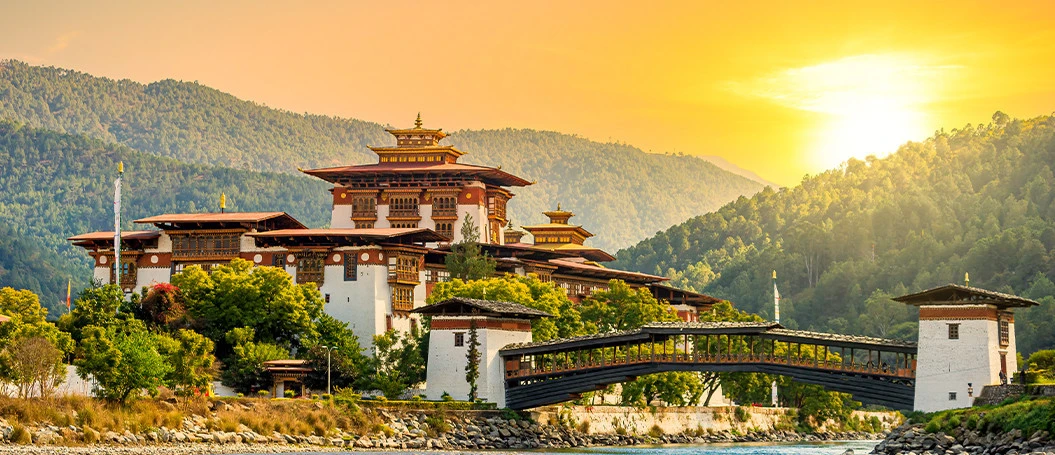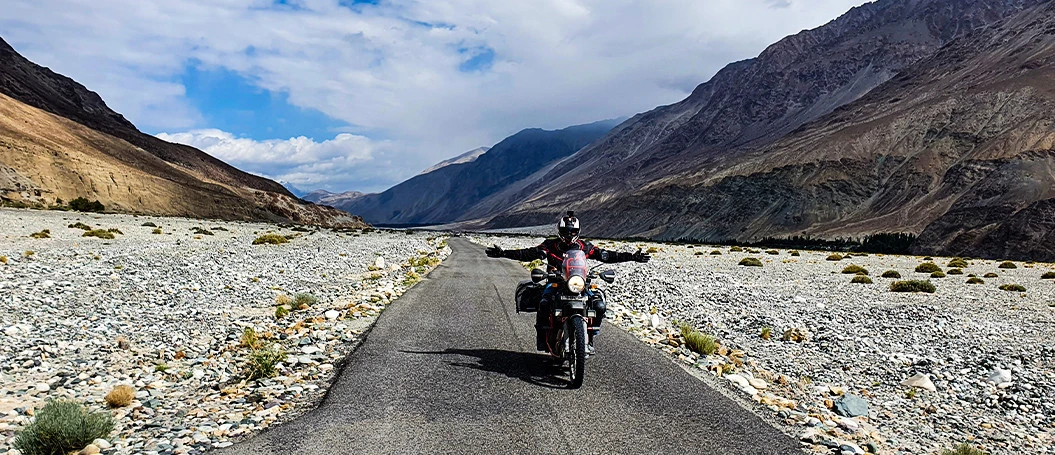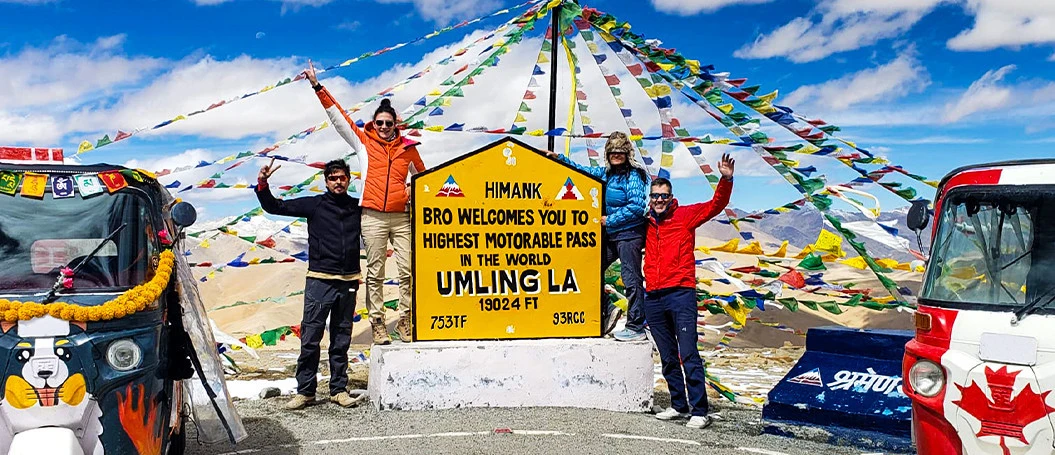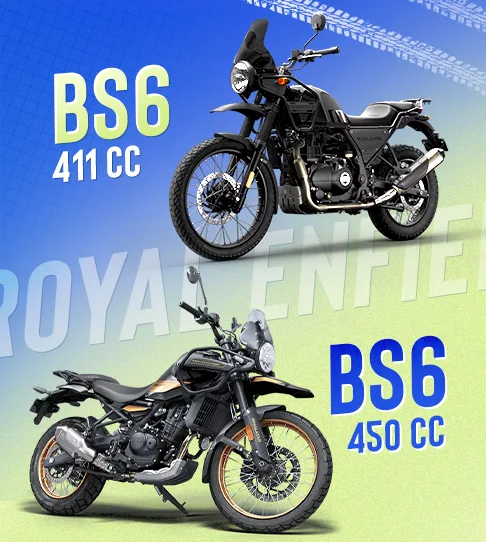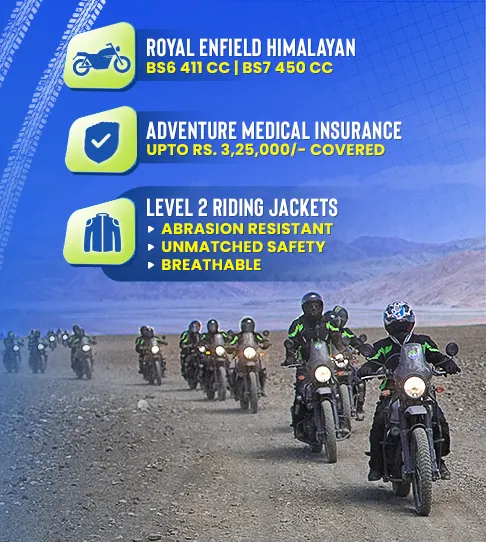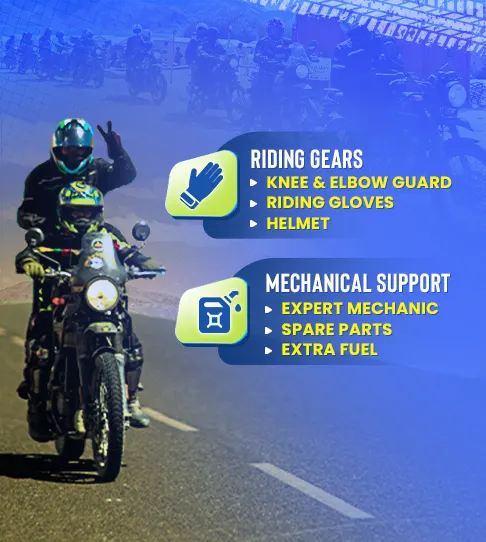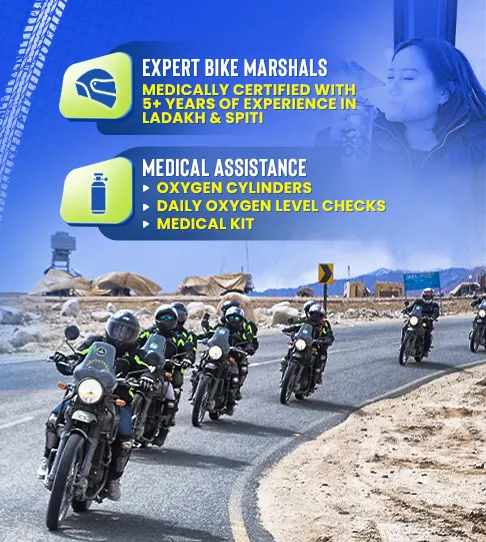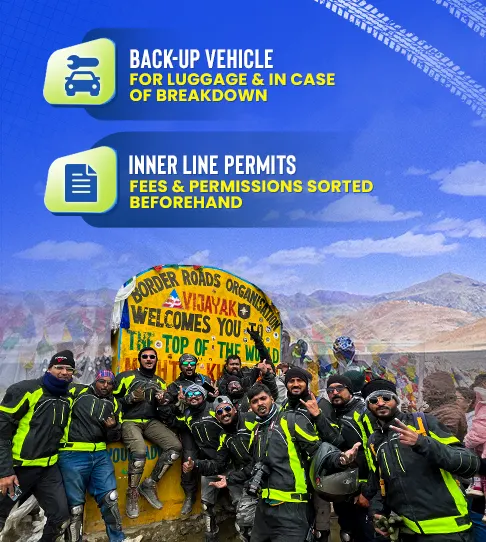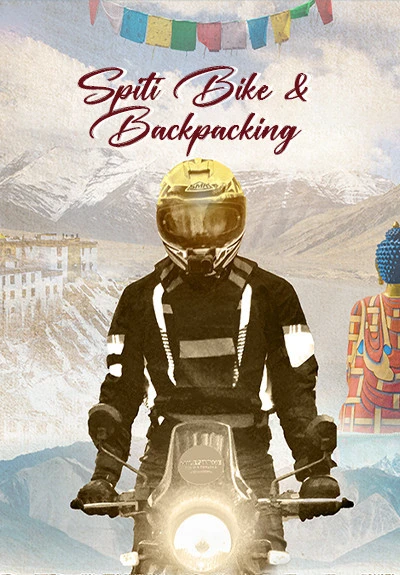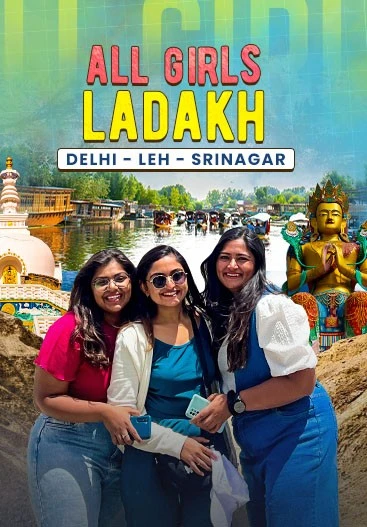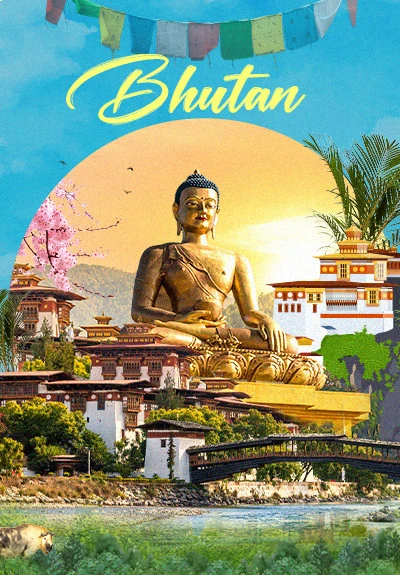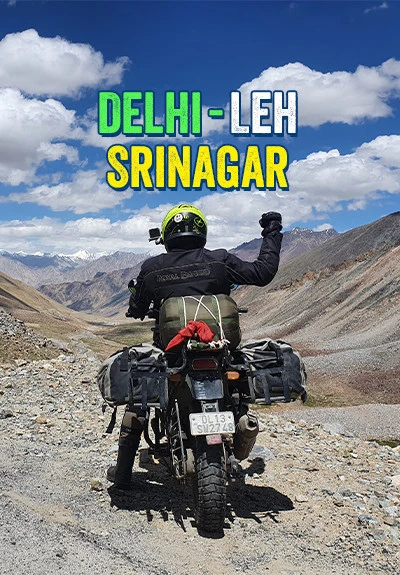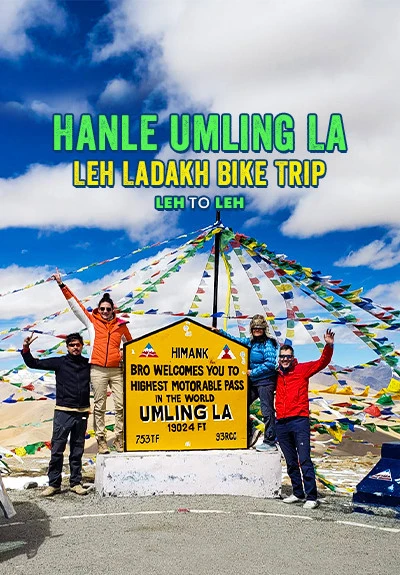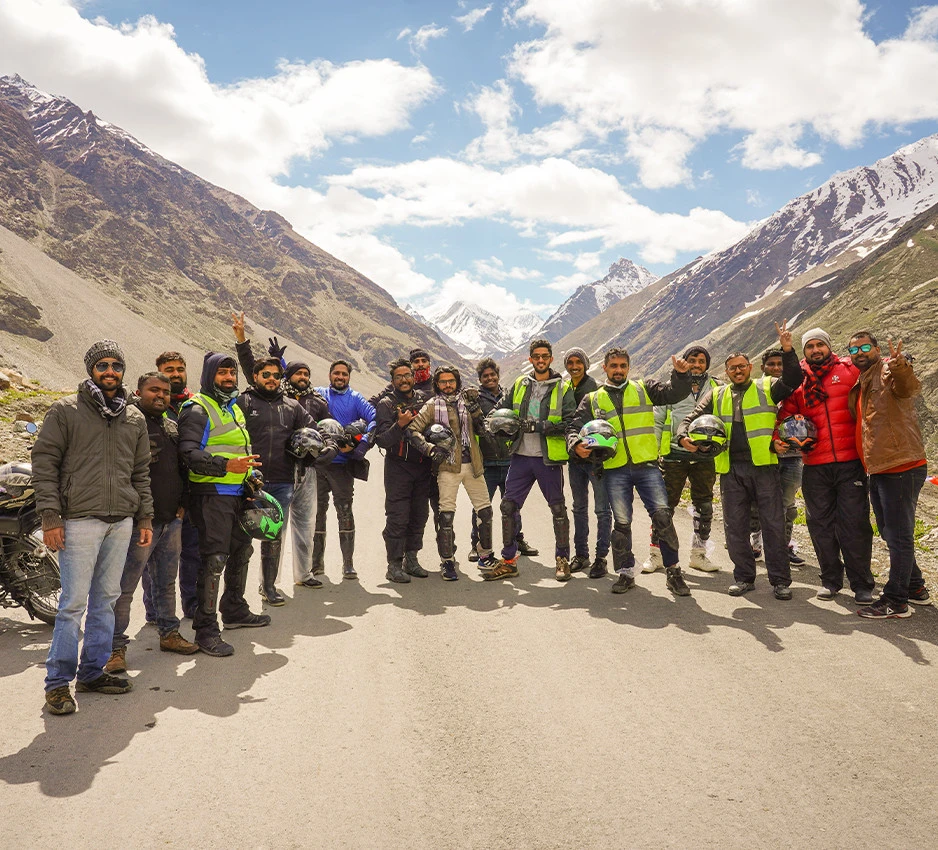
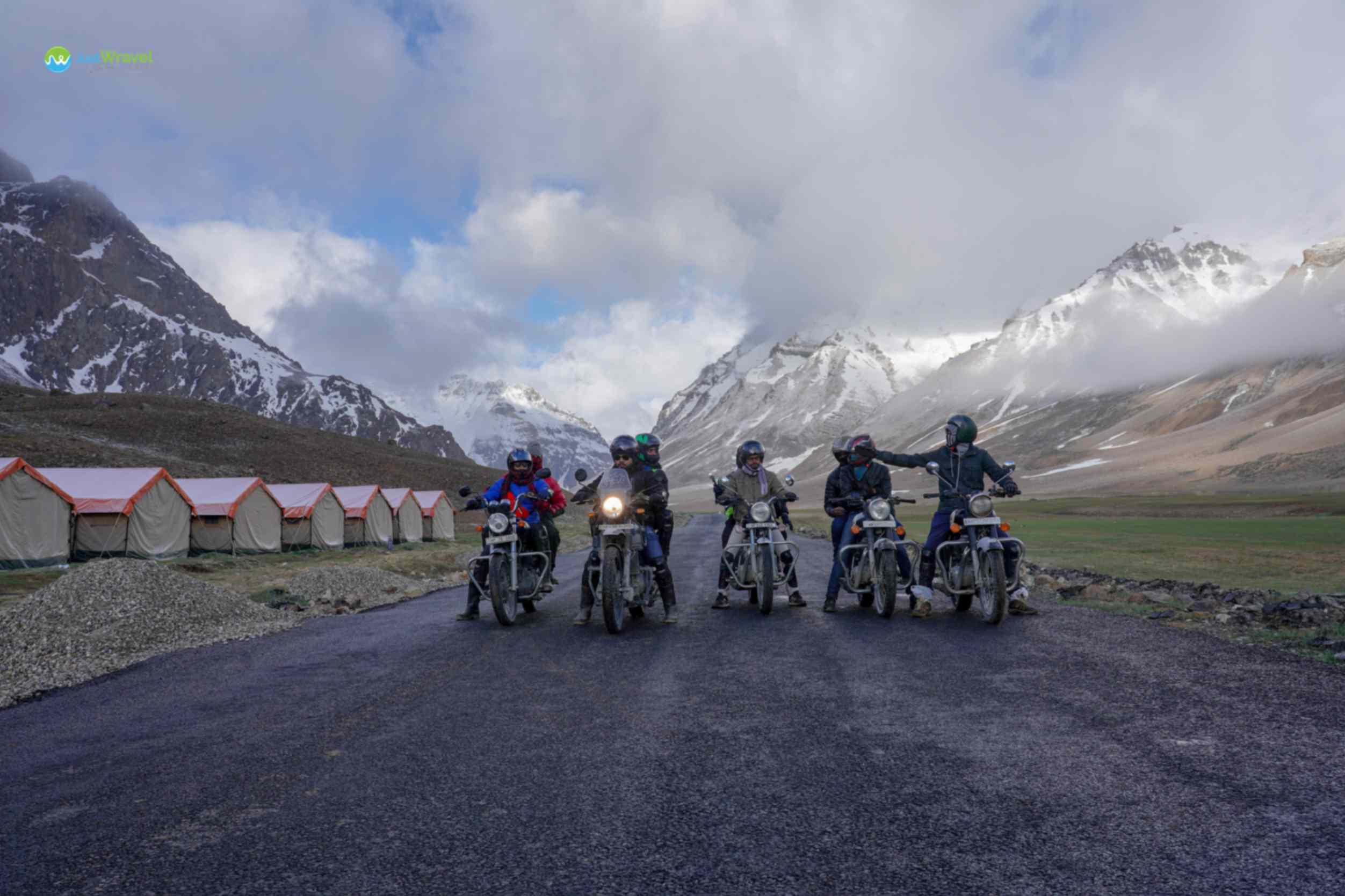
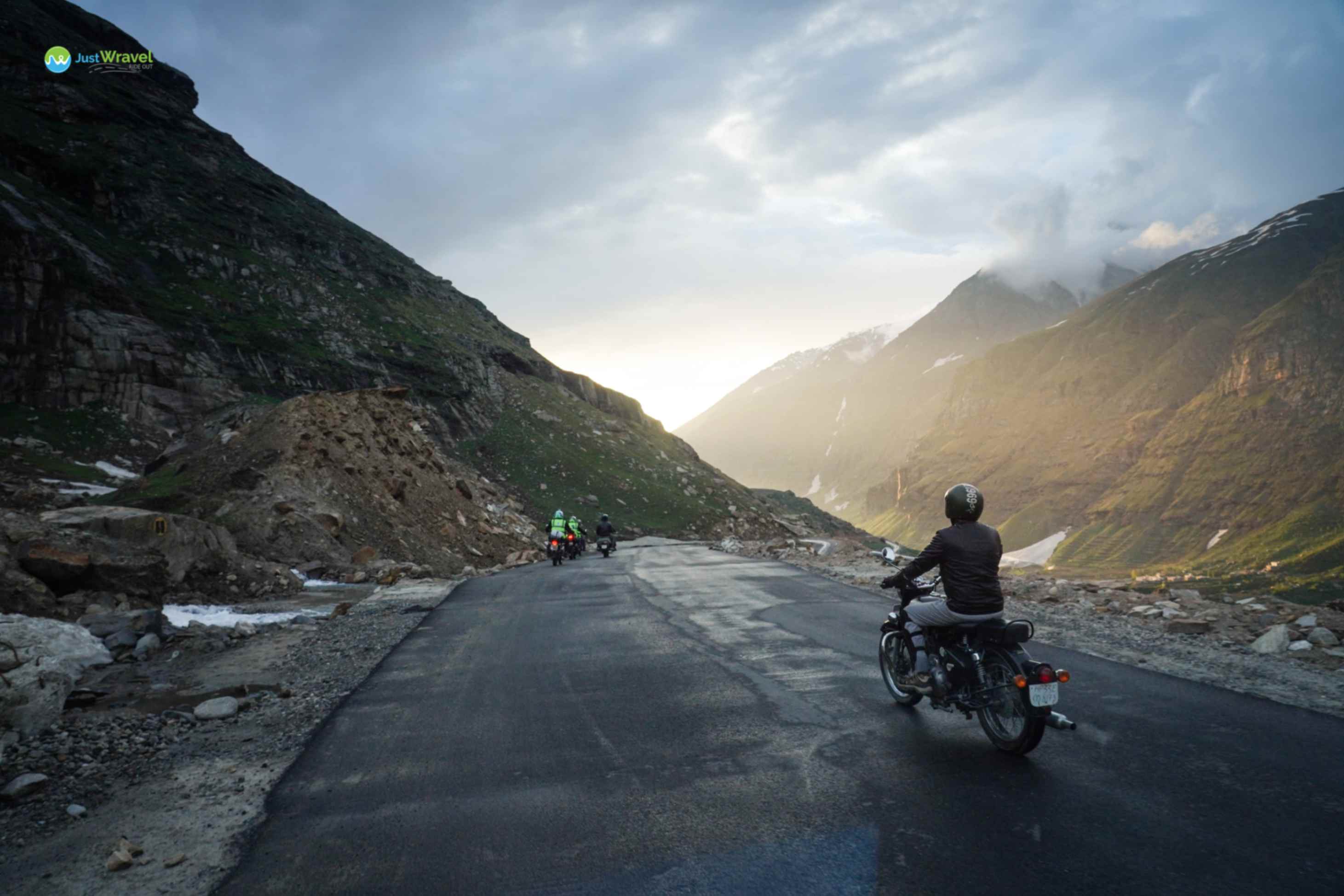
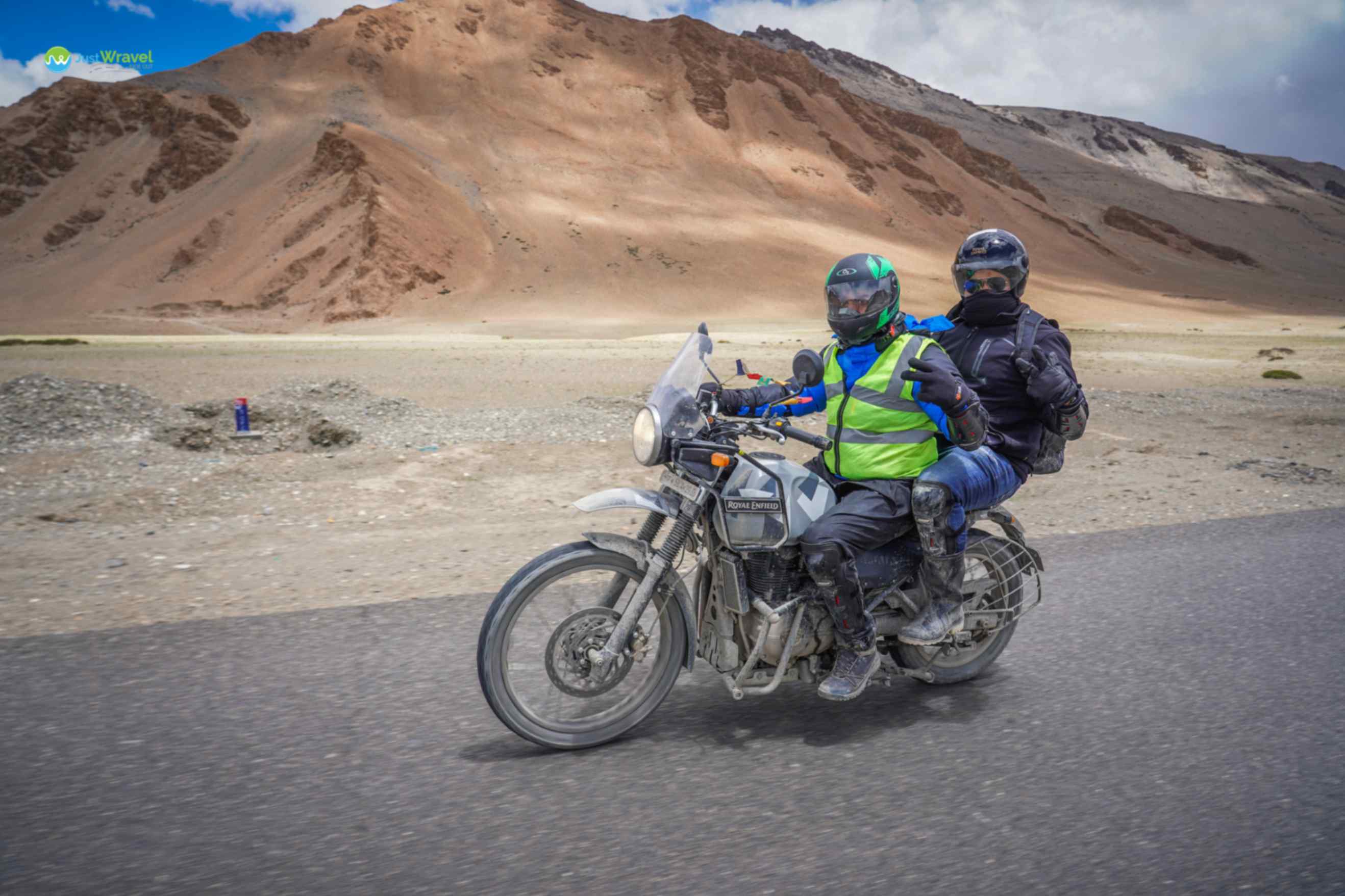
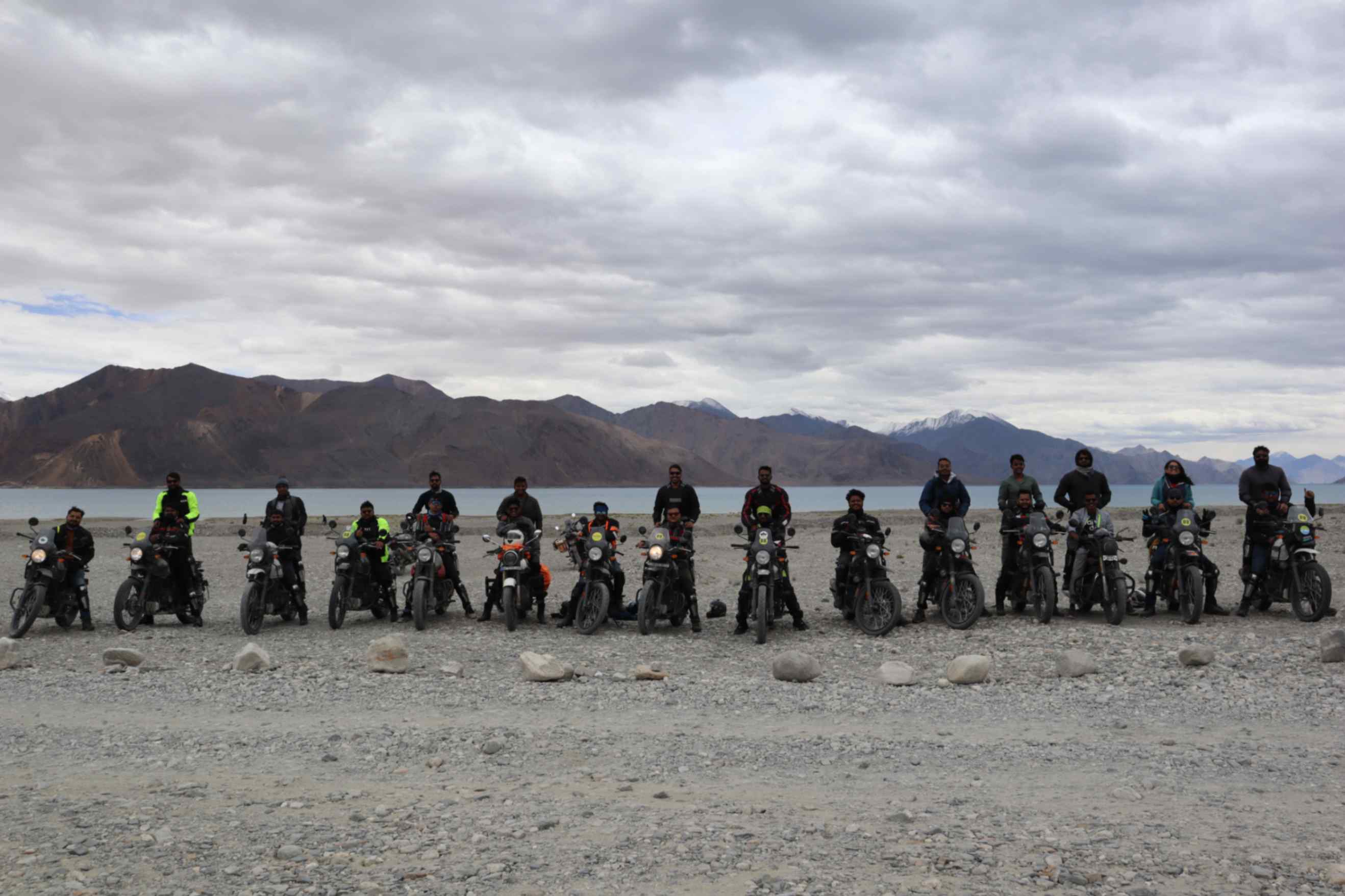
Leh Ladakh Bike & Backpacking Trip (Delhi to Delhi)
Details
Inclusions
Safe Travel
Flexible Cancellation
Easy EMI
Certified Captains
24/7 Support
Overview
A Leh Ladakh bike trip is on top of the bucket list of many travelers. The reason is that Ladakh is renowned for being a biker's paradise. The ever-changing terrains, the thrill of offroading, and the contrasting landscape make it a dream destination. In the past few years, the popularity of Ladakh has increased tenfold. Travelers from all over the globe come to visit the Land of High passes for many different reasons but the topmost reason remains the same, a bike trip where they get to traverse through jagged roads, dirt terrains, and the many high passes that Ladakh has to offer.
The adrenaline rush that riders experience when they embark on a Leh Ladakh bike trip is unsurpassable and though the land has remained true to its nature, it has also let travelers unravel the many hidden gems that remained unexplored for a long time. When it comes to the ideal route choice for a Ladakh bike trip for all adventure enthusiasts, the Manali Leh route remains on top simply because it offers the most stunning views of the Himalayas. Not to mention the contrasting backdrops that you’d be witnessing when driving from the lush green valleys of Kullu to when you finally end up in the barren lands of Ladakh.
The Manali Leh route stretches up to an expanse of 474 Kilometers and it allows you to traverse through many high motorable passes as well. In this Leh Ladakh bike trip itinerary, we first make our way from Manali to Jispa as we ride through the iconic Atal Tunnel which is nestled at an altitude of 10,000ft in the Pir Panjal ranges of the Himalayas. As we keep moving forward, towards Sarchu which is an extremely important halt point on this Leh Ladakh bike trip as this is where we spend a day so that our body can get acclimatized to the change in weather as well the high altitude. En route to Sarchu, we’d also be traversing through Baralacha La Pass which is nestled at an altitude of 15, 910 ft. The trickiest part about the Manali Leh route is that since you are gaining altitude almost every day, it becomes a bit complex for your body to get adapted to the conditions as quickly as you’d like which is why it’s important to stay hydrated throughout the journey up until you reach Leh. En route to Leh, you’d get to witness many other fascinating spots which make this Ladakh trip even more interesting. Just after Sarchu, you’d be passing through Gaata Loops which consists of 21 hairpin bends that act as loops when you’re driving through them. After riding on the jagged roads for a few more hours, you’d finally see a vast stretch of barren land signifying that you’ve reached the More plains which live up to its name and is perhaps the only longest plain route you’d get to ride on throughout your Ladakh Bike trip. Soon, you’ll be traversing through Tanglang La pass which is yet another iconic pass that contributes to the grandeur of Ladakh and its terrains.
The last stop just before you reach Leh is the small village of Upshi which lies along the Indus river and is one of the highest civilized settlements in India. Finally, the heart of Ladakh with its rainbow-colored markets and rich culture would welcome you with open arms. The reason why Leh remains the main attraction of Ladakh is not just because it’s the largest city of the union territory but also because it acts as a link between Ladakh and the rest of the people because of its developed economy and tourism which allows travelers to try Ladakhi cuisine, shop souvenirs and take a dive in the rich culture. A Leh Ladakh bike trip is incomplete without a local sightseeing tour where you get to visit all the best places in the Leh district. The first stop is Sangam which is the confluence of the Indus and Zanskar river where the pristine blue streams of the former meet the muddy brown tides of the latter making it a fascinating sight to behold. The next stop is the holy Gurudwara Patthar Ganj Sahib which has its origins back in the legend of when Guru Nanak Sahib was traveling throughout the diverse lands of our country. Today, the place of worship attracts thousands of devotees and is managed by the Indian army. The fact that people belonging to different religions and ones with different beliefs come here to pay their reverence is what makes this site so significant.
The next stop on the sightseeing tour is the Magnetic hill which is believed to have anti-gravity properties where if you were to drive on a specific spot, your vehicle would ride uphill even if you intend to drive it in the opposite direction. A place with such a mysterious aspect to it has managed to garner a lot of attention in the past few years even though it has been stated that optical illusion is at play when it comes to this hill. The Hall of Fame which is a museum dedicated to the martyrs of the Indian Army is the next halt in this Leh sightseeing tour. The museum is taken care of by the army and has handwritten letters written by the soldiers who lost their lives in the many battles that took place after the partition including the Kargil war of 1999. Last but not the least, the tour covers one of the most pristine structures in Ladakh, one that is considered to be the staple landmark of the land. With its white dome structure, the Shanti Stupa holding ancient relics of Buddha is one of the most popular attractions in Leh. Situated on the highest top in Leh, at an altitude of 11,841ft the stupa was enshrined by the Dalai Lama himself and is adorned by intricate carvings giving it the serene beauty that it holds on the entirety of its surface. In recent years with increased tourism, Ladakh has unraveled itself to be more than just a biker’s dream destination. Although the terrains make sure to capture the attention of any riders, there are many other beautiful gems that Ladakh holds in its embrace that have put the land of high passes on the radar of all kinds of travelers.
One such gem is Nubra Valley, nestled at an altitude of 10,000ft, the valley is signified for being the point where the Shyok River meets the Nubra river. Although vegetation is scarce in Nubra, the valley is known for its riverbeds and variety of fruits and nuts. The ride up to Nubra is equally rewarding as you get to traverse through the Khardung La pass which is yet another popular high-motorable pass. Nubra also offers opportunities for adventure enthusiasts to indulge in activities like ATV rides as well as the Double Hump Bactrian camel safari which is a unique safari that you won’t get anywhere else because of the double hump camels only exist in this region. After spending a night in Nubra, we will head toward our next destination. One of the highest saltwater lakes in our country, Pangong Tso is a popular attraction in Ladakh ever since it was featured in the movie 3 idiots. However, its pristine beauty and the fact that it changes color according to the direction of the sun are what have fascinated tourists from all over the globe even before it blew up and became a mainstream spot. En route to Pangong lake, we pay our reverence at Diskit Monastery which is one of the oldest as well as the largest gompas in Ladakh and is abode to the 104ft tall notable Buddha statue that overlooks the Shyok River. At an altitude of 10,315 ft, the monastery holds extreme significance to Nubra as well as the entirety of Leh.
After spending a night camping by the beautiful Pangong, we’d head back to Leh and this mini road trip would allow us to traverse the iconic Changlang La Pass which is nestled at an altitude of 17, 688ft one of the highest mountain passes in the world. We’d make a brief pit stop at Shey Palace as well as Thiksey monastery, both of which are extremely important and significant parts of Ladakh’s culture and heritage. On one hand, Shey Palace is actually a complex of many structures nestled on a hillock. It is most notable for being the abode to the second-largest Buddha statue in Ladakh which is made out of copper and gilded with gold. Thiksey Gompa, on the other hand, is the largest gompa in central Ladakh and has the largest statue of Maitreya Buddha which is as tall as a two-story building. Dalai Lama himself commemorated the temple in the monastery in 1970 which is why it is regarded as a sacred place of utmost significance. After visiting all the attractions of Ladakh, we will commence our return journey by heading back to Jispa. The best part about this Leh Ladakh bike trip is that even as you’re heading back to Manali through Jispa, you’d again be enjoying the thrill that comes with riding through the ever-changing terrain and a contrasting landscape that shifts from the cold deserts of Ladakh to lush green valleys of Kullu. The best time to do a Leh Ladakh bike trip is easily from June onwards because, by that time, the snow melts away completely giving plenty of time for the authorities to restore the roads and open all the passes including Baralacha La, without which the bike trip would remain incomplete. One of the most significant reasons why Ladakh has remained so popular among bikers is because it has always been the perfect offroading destination. But at the same time, Ladakh embodies the balance between thrill and calm beautifully and that is why it has surpassed itself as a dream destination and has become a part of the bucket list of not just bike riders but tourists as well. This Leh Ladakh bike trip offers you a glimpse at everything that Ladakh has to offer, from barren deserts to riverbeds to monasteries. Ladakh has something for every kind of traveler, be it an adventure enthusiast or someone looking for peace.
Gallery




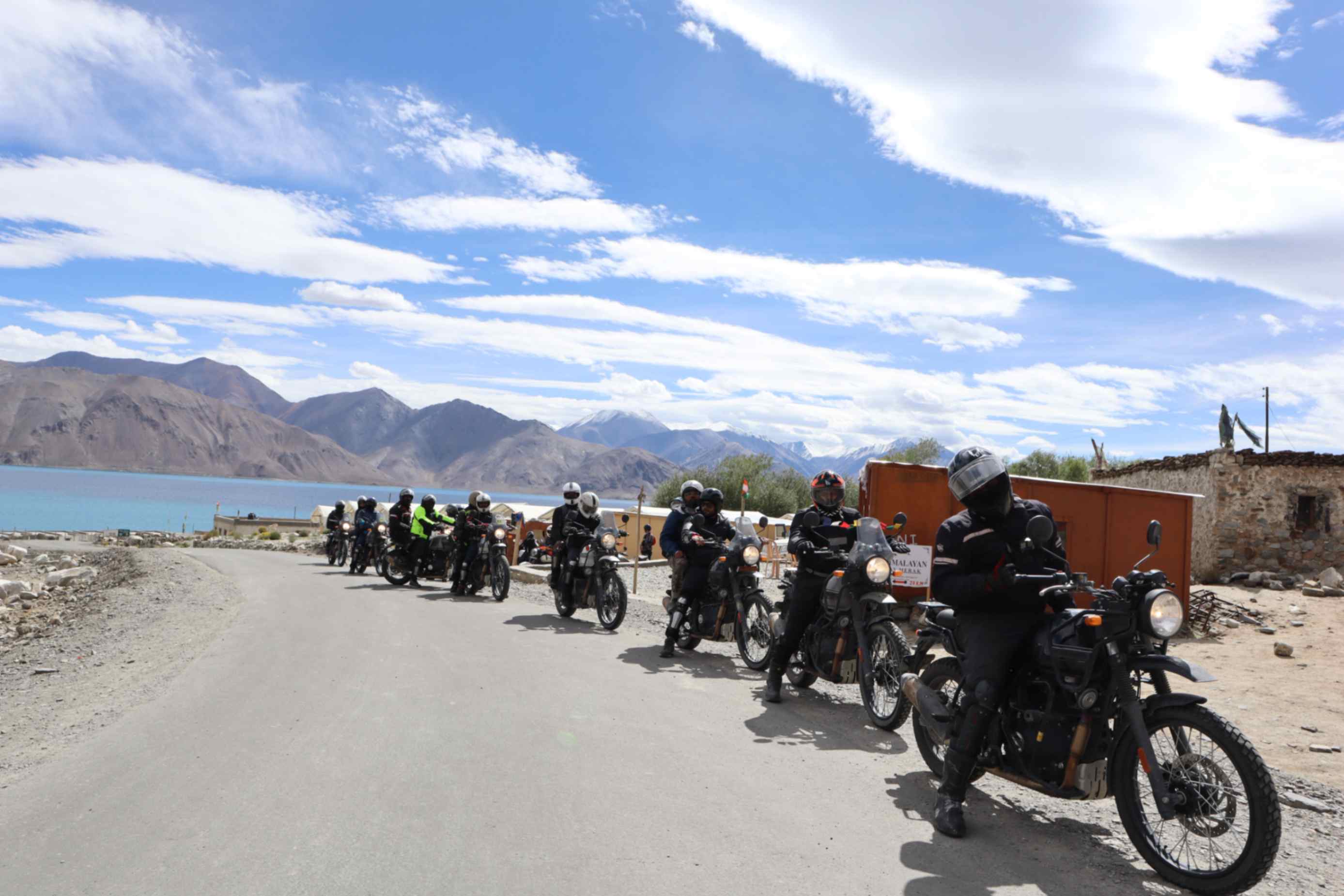
Itinerary
1
Day
Delhi to Manali | Overnight Journey
2
Day
Manali Arrival | Leisure Day
3
Day
Manali to Sarchu (177Kms) Via Ata; Tunnel
4
Day
Sarchu to Leh (230 Kms) Via Nakee La
5
Day
Leh Exploration Day
6
Day
Leh to Nubra Valley (130 Kms) Via Khardung La
7
Day
Nubra Valley to Pangong (180 Kms) Via Diskit Monastery
8
Day
Pangong to Leh (150 Kms) Via Chang La
9
Day
Leh to Jispa (334kms)
10
Day
Jispa to Manali (200 Kms) Via Atal Tunnel
11
Day
Delhi Arrival | Tour Ends
Age Limit (Trip Wise)
Weekend
Getaways
18-38
Himalayan
Treks
18-48
Backpacking
Trips
18-40
Biking
Trips
18-45
Customized
Trips
No Limit
Inclusions & Exclusions
| Inclusions | Exclusions |
Transportation in Tempo Traveller from Manali to Manali AC Volvo Bus from Delhi to Manali and return Himalayan BS6 Bike Surface transfer from Manali to Sarchu and vice versa in tempo travelers for bikers. Bike Rent with Fuel from Sarchu to Sarchu Riding Gears: Knee guard, Elbow guard, Helmet. Note: Due to comfort and safety reasons, we recommend you all to carry your own helmets for the ride. The helmets which we provide are of standard size so there can be some discrepancies regarding the sizes. Accommodations on sharing basis as per itinerary. The cost for double sharing will differ. Meal Plan: MAP (Total 16 Meals - 1 Meal on Day 2 (D) + 2 Meals on Day 3 (B+D) + 2 Meals on Day 4 (B+D) + 2 Meals on Day 5 (B+D) + 2 Meals on Day 6 (B+D) + 2 Meals on Day 7 (B+D) + 2 Meals on Day 8 (B+D) + 2 Meals on Day 9 (B+D) + 1 Meal on Day 10 (B)) Trip Lead will be present at all times during the tour. Adventure Medical Insurance - The insurance provided will cover the journey from base to base. In this case, the insurance coverage applies specifically from Manali to Manali, excluding any travel before reaching or after departing. Mechanical Support Backup Vehicle Inner Line Permits First Aid Kits Oxygen Cylinders Oximeter | 5% GST Early check-in (Before 1:00 PM) & Late Check-out (After 11:00 AM) at the hotel. Any additional expenses such as personal nature. Additional accommodation/food costs incurred due to any delay in travel. Cost Of Any Spare Part Which Will Be Used Due To The Accidental Damage Incurred When The Motorbike Is In Rider’s Possession. Cost Incurred To Transfer Or Tow The Motorbike In Case It Is Dropped On The Way. Vehicle Servicing Or Maintenance Cost Any lunch and other meals not mentioned in Package Inclusions. Any Airfare / Rail fare other than what is mentioned in “Inclusions” or any type of transportation from Manali or Srinagar. Parking and monument entry fees during sightseeing. Additional Costs due to Flight Cancellations, Landslides, Roadblocks, and other natural calamities. Vehicle servicing or maintenance cost and security deposit per motorbike of Rs. 5,000/-. As per the deposit policy (This is refundable at the end of the trip if there is no damage or spare parts required. The refund would be credited after 7 business days) Any other services not specified above in inclusions. |
Cancellation Policy
| Upto 30 days | 29-21 days | 20-15 days | 14-0 days | |
| Batch Shifting | ||||
| Cancellation Charge | Free Cancellation | 25% of the Trip Amount | 50% of the Trip Amount | 100% of the Trip Amount |
| Booking Amount | Refunded in mode of Credit Note | Adjusted in Refund Deduction | Adjusted in Refund Deduction | No Refund |
| Remaining Amount | Full Refund (minus) booking amount | Refund (minus) 25% of the trip amount | Refund (minus) 50% of the trip amount | No Refund |
Payment Policy
| Upto 30 days | 29-21 days | 20-15 days | 14-07 days | |
|---|---|---|---|---|
| Booking Amount | ||||
| 50% Payment | Optional | Compulsory | ||
| 75% Payment | Optional | Optional | Compulsory | |
| 100% Payment | Optional | Optional | Optional | Compulsory |
Things To Pack
Rucksack:
You must pick a good quality backpack with a comfortable fit and straps that won’t give you shoulder pain. You can check out your nearest Decathlon store for a good trekking backpack.
You must pick a good quality backpack with a comfortable fit and straps that won’t give you shoulder pain. You can check out your nearest Decathlon store for a good trekking backpack.
Day Bag / Day Pack:
When you head towards the summit, you are required to carry only a few necessary items and for that, you need a day backpack as you will leave your bigger one on the campsite.
When you head towards the summit, you are required to carry only a few necessary items and for that, you need a day backpack as you will leave your bigger one on the campsite.
Hiking Shoes :
Durable footwear designed for rugged terrains.
Durable footwear designed for rugged terrains.
Floaters or Sandals:
Although the entire trek requires a good quality shoe, you still need to let your feet breathe to avoid chafing and blisters. When you are at the camp, a good pair of sandals and floaters will help you to move freely.
Although the entire trek requires a good quality shoe, you still need to let your feet breathe to avoid chafing and blisters. When you are at the camp, a good pair of sandals and floaters will help you to move freely.
Tees / Tshirts:
You must keep at least three pairs of quick dry tees so that you can wash them in between stops for proper hygiene.
You must keep at least three pairs of quick dry tees so that you can wash them in between stops for proper hygiene.
Poncho:
A poncho is an evolved form of a raincoat that provides coverage to your body as well as your bag and ensures total water protection from rain.
A poncho is an evolved form of a raincoat that provides coverage to your body as well as your bag and ensures total water protection from rain.
Quick Dry Towel:
A quick dry towel will help in maintaining proper hygiene. It must dry quickly because the wet fabric will only increase the chance of bacterial growth.
A quick dry towel will help in maintaining proper hygiene. It must dry quickly because the wet fabric will only increase the chance of bacterial growth.
Sanitizer:
Essential for maintaining cleanliness while trekking.
Essential for maintaining cleanliness while trekking.
Sun Cap / Hat:
A lightweight sun cap with side flaps is perfect to keep your head cool and avoid sunburns on a sunny day.
A lightweight sun cap with side flaps is perfect to keep your head cool and avoid sunburns on a sunny day.
Sunscreen SPF 40+:
To avoid sunburns and chafing, you need to put on sunscreen as well as cold cream.
To avoid sunburns and chafing, you need to put on sunscreen as well as cold cream.
Water Bottle (Re-usable):
Hydration is extremely important when it comes to trekking. Carrying a water bottle that you can refill with Himalayan water is a must.
Hydration is extremely important when it comes to trekking. Carrying a water bottle that you can refill with Himalayan water is a must.
Personal Toiletries:
A bag with all your essentials including napkins, toothpaste, sanitizers, paper soap, etc should be carried in a ziplock bag.
A bag with all your essentials including napkins, toothpaste, sanitizers, paper soap, etc should be carried in a ziplock bag.
Personal Medication / First Aid:
A few cuts and bruises are almost inevitable when you are on a trek so carrying a medical kit with bandages, Dettol, etc is necessary.
A few cuts and bruises are almost inevitable when you are on a trek so carrying a medical kit with bandages, Dettol, etc is necessary.
Sun Glasses / Reading Glasses:
Photochromatic glasses are specs that are designed to transform into anti-glare shades depending upon exposure to the sun. They are good when it comes to eye protection but one can also opt for clip-on glasses etc.
Photochromatic glasses are specs that are designed to transform into anti-glare shades depending upon exposure to the sun. They are good when it comes to eye protection but one can also opt for clip-on glasses etc.
Charger:
To keep your electronic devices powered during the trip.
To keep your electronic devices powered during the trip.
Power Bank:
Ensures your devices stay charged when there are no outlets.
Ensures your devices stay charged when there are no outlets.
Personal Documents & ID's:
Identification proofs like Aadhar Card, Drivers License.
Identification proofs like Aadhar Card, Drivers License.
Laundry Bag (Waterproof):
In case your clothes get wet or your garments don’t dry, you can carry them in polythene. However, make sure that all the plastic that you are carrying into the woods leaves with you. Don’t litter in the mountains.
In case your clothes get wet or your garments don’t dry, you can carry them in polythene. However, make sure that all the plastic that you are carrying into the woods leaves with you. Don’t litter in the mountains.
Track Pants:
A good pair of track pants made of polyester will let your skin breathe. They’re lightweight, dry easily, and comfortable to walk around in. You can easily avoid chafing and rashes by investing in a good pair of track pants.
A good pair of track pants made of polyester will let your skin breathe. They’re lightweight, dry easily, and comfortable to walk around in. You can easily avoid chafing and rashes by investing in a good pair of track pants.
Trekking Shoes:
A good trekking shoe is comfortable, provides ankle support, and has a good grip as well. They shouldn’t be chunky, instead, they should be lightweight and sturdy.
A good trekking shoe is comfortable, provides ankle support, and has a good grip as well. They shouldn’t be chunky, instead, they should be lightweight and sturdy.
Cotton Socks:
Cotton socks are extremely comfortable to move around in and are lightweight as well which is why you can always count on a good pair of cotton socks while trekking. However, keep in mind to change them and avoid wearing them when they are wet.
Cotton socks are extremely comfortable to move around in and are lightweight as well which is why you can always count on a good pair of cotton socks while trekking. However, keep in mind to change them and avoid wearing them when they are wet.
Woolen Socks:
A good pair of woolen socks, especially merino, are comfortable, limit odors and provide adequate insulation from the cold so you can wear them at night.
A good pair of woolen socks, especially merino, are comfortable, limit odors and provide adequate insulation from the cold so you can wear them at night.
Woolen Gloves:
Insulated gloves help in maintaining proper body heat in your hands and also provide a better grasp on trekking poles.
Insulated gloves help in maintaining proper body heat in your hands and also provide a better grasp on trekking poles.
Main Jacket:
It’s emphasized that you need to carry proper layers so you can avoid getting cold which is why you need to carry a heavy jacket that you can put on over your other clothes.
It’s emphasized that you need to carry proper layers so you can avoid getting cold which is why you need to carry a heavy jacket that you can put on over your other clothes.
Woolen Cap:
A woolen cap will help prevent cold when you ascend to high altitude. You can also cover your ears to avoid any pain and discomfort you might face in them when going at high altitudes.
A woolen cap will help prevent cold when you ascend to high altitude. You can also cover your ears to avoid any pain and discomfort you might face in them when going at high altitudes.
Hoodie:
A versatile layering option for various temperatures.
A versatile layering option for various temperatures.
Scarf / Balaclava:
Along with sun rays and chilly winds, you also get hit by dirt and grime during treks which is why it's important to carry a scarf or balaclava so you can cover your face when needed.
Along with sun rays and chilly winds, you also get hit by dirt and grime during treks which is why it's important to carry a scarf or balaclava so you can cover your face when needed.
Head Lamp:
You can’t rely on moonlight when you are in the mountains. A torch or even a headlamp with a fresh pair of batteries is always a good idea to bring along.
You can’t rely on moonlight when you are in the mountains. A torch or even a headlamp with a fresh pair of batteries is always a good idea to bring along.
Trekking Pole:
The trekking pole assists in more than one way. It saves energy while also providing stability and helps you to maintain proper balance.
The trekking pole assists in more than one way. It saves energy while also providing stability and helps you to maintain proper balance.
Camera:
This should be obvious. To make sure that you get to capture all the great moments from your trek. Make sure that you have enough storage and some extra batteries as well.
This should be obvious. To make sure that you get to capture all the great moments from your trek. Make sure that you have enough storage and some extra batteries as well.
Riding Gear:
If your trip involves biking or motorcycling.
If your trip involves biking or motorcycling.
Moisturiser & Cold Cream:
To avoid sunburns and chafing, you need to put on sunscreen as well as cold cream.
To avoid sunburns and chafing, you need to put on sunscreen as well as cold cream.
Lip Balm:
Your lips can become chapped due to the harsh cold winds so it's important to keep them moisturized.
Your lips can become chapped due to the harsh cold winds so it's important to keep them moisturized.
Sanitary Pads:
Essential for feminine hygiene.
Essential for feminine hygiene.
Insect Repellent:
Guards against pesky bugs and insects.
Guards against pesky bugs and insects.
Cash:
Emergency funds for unexpected situations.
Emergency funds for unexpected situations.
Thermals:
Thermal is a piece of garment that helps in keeping your body warm in cold temperatures. It is a necessary item that you need when going on a high-altitude trek.
Thermal is a piece of garment that helps in keeping your body warm in cold temperatures. It is a necessary item that you need when going on a high-altitude trek.
Snacks / Dryfruits / Energy Bar:
Provides quick energy on the go.
Provides quick energy on the go.
Positive Attitude:
The most important item for a successful trek or trip, keeping your spirits high and adaptable to the challenges of the journey.
The most important item for a successful trek or trip, keeping your spirits high and adaptable to the challenges of the journey.
FAQs
What are the documents required when traveling to Ladakh?
Documents required are Identity Proof ( Aadhar Card, PAN Card, Driving License, etc) and in case, you're traveling via your vehicle, then you need to carry all your vehicular documents as well. For Foreigners, a Passport with Visa and OCI Card is mandatory.
There are certain Inner Line permits / Protected Area Permits that you need to acquire when traversing through these regions:
- Khardungla
- Nubra Valley
- Shyok
- Changla Pass
- Pangong Tso
- Turtuk
- Tang Tse
- Chumthang Valley
- Tso Moriri
- Dha Hanu Valley
- Batalik
Permits are delivered via Deputy Commissioner (DC) Office in Leh, open from Monday to Saturday (10 AM - 4 PM). These permits are valid for 3 weeks for Indian Nationals and 15 days for Foreign Tourists.
Which mobile network works well in Ladakh?
Prepaid connections don’t work in Ladakh. When it comes to mobile network providers, you can only rely on Airtel. BSNL and Jio. Here are some regions with the respective network that you can expect here:
Leh: Airtel, BSNL, and Jio users have good connectivity here.
Nubra: Jio and BSNL users get decent connectivity here.
Diskit: Jio gets decent connectivity while Airtel gets 2G/3G reception.
Zanskar: BSNL gets decent connectivity.
Drass: BSNL gets decent connectivity.
Kargil: Jio and BSNL get decent connectivity.
What are some precautions we need to take when on a bike trip to Ladakh?
As you travel to higher altitudes, your body doesn't get enough oxygen which is the main cause of AMS. This can easily be avoided if one keeps drinking water, stays hydrated, and intakes enough carbohydrate-rich foods to keep the body warm.
Another thing to keep in mind when traveling to Ladakh is that you need to wear proper layers so that your body temperature is maintained.
Most importantly, make sure you cover your ears when traversing through the high passes as the chances of you getting hit by AMS, motion sickness, and the possibility of you getting pain or discomfort are extremely high while ascending.
How long does it take one to get acclimatized in Ladakh?
The time taken to acclimatize may vary from person to person. You are traveling to a height of around 3500 meters. In most cases, people abruptly feel the changes while some people will acclimatize easily. For some people, it can take the whole first day. But in case of flying in, we do recommend 1-day of complete rest in Leh.
Additionally, for precautionary measures, one needs to spend at least 24-48 hours at rest in Leh to get acclimatized properly.
Does it get difficult to breathe in Ladakh?
Nestled at an elevation of almost 11,500 ft Ladakh is a high-altitude region and if you're traveling from the plains, then you will start to face some difficulty as the atmospheric pressure drops. As a result, there is less oxygen in the air the higher you go.
You might get hit by a wave of AMS (Acute Mountain Sickness) where your symptoms would breathlessness would be a major symptom while the other symptoms would include headache, nausea, vomiting, indigestion, and more. It is important to keep drinking water and give your body at least a day so that it can get acclimatized properly.
Read more about AMS here: https://www.justwravel.com/blog/a-guide-to-ams/
How to do a Leh Ladakh Bike Trip from Delhi?
The optimum way in which we can conduct a bike trip to Leh Ladakh from Delhi is via the Manali route. Start off from Delhi on your own bike or a Volvo to Manali and rent a bike there. On reaching Manali, obtain the necessary permits which will be easily facilitated by local guides, bike vendors, and more. On crossing Rohtang Pass, you'll be reaching Sarchu, which is the starting point of Leh Ladakh, and Voila! You've begun your epic bike trip to Leh Ladakh from Delhi.
Is it safe to do a Leh Ladakh Bike Trip from Kashmir?
Although it is safe to do a Ladakh bike trip from Srinagar to Leh, sometimes it depends on the situation on the international borders. We have faced roadblocks around Srinagar if the situation is not conducive for the trip. It is advisable to check with the locals and also the weather forecast before leaving for the trip.
Which is the best tire for a Ladakh Bike Trip?
Always go for semi-off-road tires when it comes to Ladakh bike trips or tires with the 70/30 compound tire. The best-budgeted tire for the Ladakh bike trip is Timson.
How to rent a bike for a Leh Ladakh Bike Trip?
You can easily rent bikes from Manali, Srinagar, and Leh. All you have to do is submit some required documents and security money and certify that you're having a valid driver's license. Additionally, if you damage the bike during the course of the trip, you will have to pay the amount to the shop owner according to the damage incurred.
How much fuel should we carry on a Leh Ladakh Bike Trip?
The last petrol pump in the Manali-Leh route is at Tandi and then at an approximate distance of 10 kilometers before reaching Leh. In our group departures, we carry extra fuel in the backup vehicle.
For riders doing it on their own, make sure you get your bike fuelled at Manali, then refueled again at Tandi, and always keep 10 liters of fuel for backup in the extra canisters and remember to top up your tanks in the morning before starting your ride.
How to prepare for a Leh Ladakh Bike Trip?
The primary requirement for a Leh Ladakh Bike Trip is having a basic knowledge of the terrain, maps, bike mechanism, and more.
Ladakh is a cold desert and the weather condition changes there from minute to minute, so being mentally and strategically prepared is always good. There is no network, so you cannot ca anybody for help, and should always be self-reliable.
Keep a daypack with all your essentials such as medication including Diamox for AMS, a small oxygen cylinder, a water bottle, and more. Be sure to get to know your bike and how to tackle some common emergencies. Take a physical map of the terrain and make sure that you know how to use the same. Also, have the proper gear and extra layers of Clothes to keep you warm.
Check out more Ladakh Travel Tips here: https://www.justwravel.com/blog/ladakh-travel-tips-things-to-keep-in-mind-before-visiting-ladakh/
What are the mandatory riding gears required for Leh Ladakh Bike Trip?
A helmet, level 2 riding jacket, riding pants, waterproof shoes, long-length waterproof riding gloves, and riding gear (hydra pack), are some of the biking gears that are essential.
What extra spare parts should we carry while on a Ladakh Bike Trip?
Clutch wire, acceleration wire, brake pads, and puncture kit are the main biking essentials that you should carry with you at all times. Not forgetting the canisters for extra fuel when on a Leh Ladakh bike trip.
What are the best Bikes to choose for the Leh Ladakh Bike Trip?
Individuals have done these kinds of trips even on their bicycles or 100 CC bikes such as Splendor or similar ones. But ideal bikes are majorly royal Enfield 350 CC, Royal Enfield 500 CC, and Himalayan. If you're riding solo then 350 CC or above will be a comfortable choice and the same goes for 500 CC and above for dual riders.
We usually do our Leh Ladakh Bike Trips on the Royal Enfield Himalayan.
What is the best time to go on a Leh Ladakh Bike Trip?
The best time for a Leh Ladakh Bike trip is from June to September because, during the rest of the months, the passes remain closed due to heavy snowfall. So it is impossible for a biker to do a bike trip to Ladakh anytime before mid-May-June. The best part about going on a bike trip during these months is that you'll be able to traverse almost every iconic high-altitude pass that bikers love.
You can read all about the High Passes that bikers love here: https://www.justwravel.com/blog/high-passes-of-ladakh-that-bikers-love/
How can we reach Ladakh?
You can reach Ladakh via road or by flight.
When it comes to flights, you can land at Leh Airport as it is connected to major cities like Delhi, Chandigarh, and Srinagar, through direct and connecting flights.
When it comes to roads there are two routes. One is from Manali and the other is via Srinagar. If you're traveling via Manali, you'll need to cover a distance of approximately 474 kilometers while the Srinagar route is shorter in comparison with a stretch of 434 Kilometers of road.
Is this trip mainly focused on biking, or can I choose a Tempo Traveler instead?
Certainly! At JustWravel, we understand Ladakh's allure, and we offer options to suit your preferences. Whether you are drawn to the thrill of biking or prefer the ease of a Tempo Traveler, the decision is entirely yours. In Ladakh, you have the option to either ride through its stunning landscapes on a bike or relax in the Tempo Traveler while constantly looking out for the majestic views.
Which option is preferable, biking or Tempo Traveler for Ladakh?
Both biking and traveling via Tempo Traveler offer distinct experiences. In Ladakh, regardless of your chosen mode of transport, the itinerary, destinations, and activities remain same. However, your choice may depend on factors like your physical condition, comfort preferences, and overall health. Rest assured, each aspect of your journey is carefully planned to ensure an unforgettable adventure in Ladakh.
Everything you need to know about Ladakh
If you are planning a Leh Ladakh Tour, numerous questions will keep coming to your mind. A trip to Ladakh is different from other destinations because of its uniqueness and adventurous side.
Ladakh, the Land of High Passes, is a recently designated Union Territory in India that was previously a part of Jammu & Kashmir. Its scenery is awe-inspiring, with mountains, snow, cold desert, alpine meadows, and lakes all nearby, providing a unique and dramatic landscape. The challenging terrain of Leh Ladakh in the Himalayas invites you to experience a completely new way of life. This place is awe-inspiring and breathtaking due to its purity, which can awaken something within you. Leh is a small town that epitomizes a mountain town, with its stunning beauty and humble, loving locals.
For nature lovers and adventurers alike, tourism in Ladakh offers an incredible experience. Ladakh, with its towering barren mountains, is known for having some of the highest motorable passes such as Khardung La (5359 m), Marsimik La (5582 m), and Chang La (5360 m), as well as picturesque alpine lakes like Pangong Tso (4350 m) and Tso Moriri (4522 m). The region of Ladakh is divided into three parts - Leh, Nubra, and Zanskar, each offering a variety of attractions to explore. The region of Leh and Ladakh exemplifies organized simplicity. Ladakh offers not just mesmerizing landscapes and adventure, but also a focused lifestyle that promotes contentment and fulfillment. Traveling to Ladakh through this Itinerary allows you to escape the rat race of everyday life and appreciate the true essence of living on Earth. When searching for Ladakh tour packages online, the desire for adventure naturally grows. This destination ignites excitement and offers a life-changing experience.
Here is everything you need to know about Leh Ladakh:
How to Reach Leh Ladakh
The Indian winter paradise of Ladakh is one of the most valued travel destinations for both nature lovers and thrill-seekers. Mountain bikers, trekkers, and hikers will love this spot. Ladakh, which is 3,001 meters above sea level, appears otherworldly with its surrounding peaks, valleys, ancient monasteries, and alpine lakes.
By Road - Despite its high elevation, major Indian towns like Srinagar in Jammu & Kashmir and Manali in Himachal Pradesh have good road connections to Ladakh. The fact remains, though, that individuals can only schedule their road travel during the first six months of the year because snowfall keeps the roads closed the rest of the time.
Biker favorite route 1 is from Manali to Leh. The Manali to Leh route is superior, more practical, and has some of the nicest views along the way. Leh is around 490 kilometers from Manali.
Route 1- Manali-Rohtang-Gramphu-Kokhsar-Keylong-Jispa-Darcha-Zingzingbar-Baralacha La-Bharatpur-Sargu-Gata Loops-Nakee La-Lachulung La-Pang-Tanglang La-Gya-Upshi-Kuru-Leh
Route 2: The roadway between Srinagar and Leh is less often traveled.
Srinagar – Sonmarg – Zozi La – Drass – Kargil – Mulbek – Lamayaru – Saspol – Leh
By Air - Air travel is one of the most convenient and pleasant methods to go to Ladakh. There are several airlines that offer direct flights to Ladakh. The Kushok Bakula Rimpochee Airport in Leh is the closest airport to the city.
Best Time to Visit Leh Ladakh
The best time to visit Leh Ladakh is from May to September. The beautiful weather and open roads to Leh make it easier to get there during this time of year.
Summer (May to September): With its pleasant temperatures and beautiful skies, summer is Leh Ladakh's busiest travel season. Visitors can experience the region's breathtaking landscapes since the majority of the routes, including high-altitude crossings and famous lakes like Pangong Tso and Tso Moriri, are open. Adventure seekers come from all over the world to participate in outdoor activities like white-water rafting, trekking, and camping because of the perfect weather.
Spring (Late April to Early May): As temperatures progressively rise and the snow starts to melt, spring signals the start of the tourist season. With snow-capped peaks in the background, the landscape comes to life with flowering flowers, even though certain higher passes may still be unreachable early in the season. Less people visit around this time, so it's ideal for individuals looking for a peaceful experience.
Autumn (late September to October): With crisper weather and colorful scenery, autumn showcases Leh Ladakh in all its splendor. Winter is coming, but the days are still nice and the nights are starting to grow chilly. Even while certain tourist attractions might close by the end of October, most attractions are still open, and there are comparatively fewer people around, making it a great time for a quiet vacation.
Winter (November to April): Because of the intense cold and a lot of snowfall, which cause road closures, particularly in higher-altitude places, winter is the off-season for tourists in Leh Ladakh. snow, however, offers special chances for those seeking adventure, such as going on snow trekking and attending customary celebrations like Losar. Even if there aren't as many amenities available, visiting Leh Ladakh in all of its icy beauty may be an unforgettable experience.
The Best Places to Visit in Ladakh
Nubra Valley - Nubra, a deep gorge created by the Shyok and Siachen Rivers, is without a doubt one of the top tourist destinations in Ladakh. In addition to being the starting point for some of the highest regions, such Siachen Glacier, it is also the location of the hot springs at Panamik settlement, the old monasteries, the sand dunes of Hunder, and the settlement split along a boundary.
Pangong Tso - One of the most well-liked and fantastic locations to visit in Ladakh is Pangong Lake, which is the highest saltwater lake in the world. Several scenes from the films 3 Idiots, Jab Tak hai Jaan, and many more were filmed there as well.
Lamayuru - Tradition has it that the Yuru Gompa, commonly referred to as the "eternal monastery," was the first Bon Monastery to be built in Ladakh.
Shanti Stupa - Ladakhi and Japanese Buddhists collaborated to construct the Shanti Stupa. This white-domed structure, perched atop a hill, is a popular tourist destination in Ladakh and is said to contain Buddha relics.
Khardung La Pass - One of the highest motorable passes in the world, the Khardung La Pass serves as a gateway to Ladakh's Nubra and Shyok Valleys.
Magnetic Hill - Magnetic Hill is a picturesque and captivating route that runs next to the Sindhu river.When you park your car in the designated white box on the road, the vehicle will begin to ascend at a rate of twenty kilometers per hour on its own. The phenomenon piques travelers' curiosity and is the subject of numerous mythology.
Tso Moriri - Tso Moriri is undoubtedly at the top of the list when it comes to Ladakh tourist destinations. Tso Moriri, the region's largest lake, is a lesser-known paradise hidden among Ladakh's high mountains. Measuring around 26 km in length and 8 km in width, it's one of the region's hidden treasures!
Diskit Gompa - One of the main draws for tourists visiting Nubra Valley is the 108-foot-tall Maitreya Buddha statue, which stands guard over the Shyok River. It was constructed to uphold the ideals of harmony and serenity as well as to keep evil out of Diskit Village.
Hanle - Hanle, another breathtakingly gorgeous location in Ladakh, is literally heaven for all astronomy enthusiasts. Situated around 250 kilometers from Leh on the historic India-Tibetan trade route, it is the site of the Indian Astronomical Observatory and one of the oldest monasteries constructed in the Indo-Chinese style.
Turtuk - Located at the northernmost point of Nubra beside the Shyok River, Turtuk is the final settlement situated in the Baltistan region along the boundary between India and Pakistan. For the Indian Army, this region is crucial since it serves as the entrance to Siachen Glacier. One of the best spots to visit in Ladakh is its apricot-laden orchards, lush plains, pure river banks, and captivating history.
Umling La - The world's highest motorable pass, Umling La, has been built by BRO (Border Roads Organization), surpassing national expectations once again and surpassing Khardung La and Mana Pass in Uttarakhand. Constructed as part of "Project Himank," the 19,300-foot road trip is sure to leave you feeling amazed, ecstatic, and full of adrenaline.
READ MORE: THE BEST PLACES TO VISIT IN LADAKH
https://www.justwravel.com/blog/best-places-to-visit-in-ladakh
Things to do in Leh Ladakh
From trekking to river rafting, there is a wide variety of activities you can do in Ladakh. To make the most out of your Leh Ladakh Tour, it is recommended for you to indulge in some of these activities.
Camel Safari In Ladakh - The sand dunes of Hunder, located in the Nubra Valley, have acquired the nickname "desert in the sky." Experience a safari on a double-humped Bactrian camel, which was formerly an essential component of the caravans.
Where to do: Nubra Valley
Mountain Biking in Ladakh - Experience the abundance of Ladakh on a mountain bike; you won't be disappointed to find some of the most captivating and seductive scenery.
Where to do: You can do the whole Ladakh circuit on Bike
River Rafting in Ladakh - Have a go at river rafting. The Indus in the Leh area, the Zanskar in Zanskar, and the Shayok in Nubra. Rafting the Zanskar River is a fun and thrilling experience.
Where to do: Zanskar River
Trekking in Ladakh - There are a plethora of breathtaking scenery in Ladakh that can leave one spellbound. It is also the ideal location for hikers. featuring some amazing vistas and routes that will change your perception of adventure.
Where to do: Lumayuru to Darcha trek, Ripchar Valley trek, Padum to Darcha trek, Lumayuru to Alchi trek, Lumayuru Stok Kangri and Markha Valley trek.
Quad Biking - You simply must go quad biking while visiting the Nubra Valley, often known as the adventure valley. The ideal approach to up the ante on your Leh Ladakh tour package excursion is to go quad biking for 45 minutes.
Where to do: Nubra Valley
High Passes of Ladakh
Ladakh is called the land of high passes for a reason. The whole region is blessed with passes that are capable of raising your adreline. Here are the famous passes of Ladakh that you can’t miss.
- Namik La (12,198 feet) - Located on the Srinagar Leh highway
- Zoji La (12,400 feet) - Zoji La means Mountain pass of Blizzards
- Fotu La pass (13,479 feet) - Lies on the Srinagar Leh circuit and is higher than the Zojila pass
- Nakee La (15,547 feet) - Third and one of the highest mountain passes between Leh to Manali.
- Baralacha La (16,400 feet) - Baralacha La has a summit with crossroads from Spiti, Ladakh, Zanskar, and Lahaul
- Khardung La pass (17,582) - Once considered to be the highest motorable road in the world
- Taglang La (17,583) - It's a beautiful journey, so make sure to stop at the pass for sweeping vistas.
- Chang La (17,585 feet) - You will encounter this pass while traveling to Pangong Tso
- Marsimik La (18,953 feet) - It is located 20 kilometers from the stunning Pangong Tso in the Chang-Chemno range.
- Umlingla Pass (19,300 feet) - Highest motorable road in India
READ MORE ABOUT HIGH PASSES OF LADAKH
https://www.justwravel.com/blog/high-passes-of-ladakh-that-bikers-love
VIDEOS
Memories for Life
posts
Instagram Images
REVIEWS
What our Clients Say About Us
blogs
Our Blogs
TRIPS
Related Trips





Leh Ladakh Bike & Backpacking Trip (Delhi to Delhi)
Details
Inclusions
Safe Travel
Flexible Cancellation
Easy EMI
Certified Captains
24/7 Support
Overview
A Leh Ladakh bike trip is on top of the bucket list of many travelers. The reason is that Ladakh is renowned for being a biker's paradise. The ever-changing terrains, the thrill of offroading, and the contrasting landscape make it a dream destination. In the past few years, the popularity of Ladakh has increased tenfold. Travelers from all over the globe come to visit the Land of High passes for many different reasons but the topmost reason remains the same, a bike trip where they get to traverse through jagged roads, dirt terrains, and the many high passes that Ladakh has to offer.
The adrenaline rush that riders experience when they embark on a Leh Ladakh bike trip is unsurpassable and though the land has remained true to its nature, it has also let travelers unravel the many hidden gems that remained unexplored for a long time. When it comes to the ideal route choice for a Ladakh bike trip for all adventure enthusiasts, the Manali Leh route remains on top simply because it offers the most stunning views of the Himalayas. Not to mention the contrasting backdrops that you’d be witnessing when driving from the lush green valleys of Kullu to when you finally end up in the barren lands of Ladakh.
The Manali Leh route stretches up to an expanse of 474 Kilometers and it allows you to traverse through many high motorable passes as well. In this Leh Ladakh bike trip itinerary, we first make our way from Manali to Jispa as we ride through the iconic Atal Tunnel which is nestled at an altitude of 10,000ft in the Pir Panjal ranges of the Himalayas. As we keep moving forward, towards Sarchu which is an extremely important halt point on this Leh Ladakh bike trip as this is where we spend a day so that our body can get acclimatized to the change in weather as well the high altitude. En route to Sarchu, we’d also be traversing through Baralacha La Pass which is nestled at an altitude of 15, 910 ft. The trickiest part about the Manali Leh route is that since you are gaining altitude almost every day, it becomes a bit complex for your body to get adapted to the conditions as quickly as you’d like which is why it’s important to stay hydrated throughout the journey up until you reach Leh. En route to Leh, you’d get to witness many other fascinating spots which make this Ladakh trip even more interesting. Just after Sarchu, you’d be passing through Gaata Loops which consists of 21 hairpin bends that act as loops when you’re driving through them. After riding on the jagged roads for a few more hours, you’d finally see a vast stretch of barren land signifying that you’ve reached the More plains which live up to its name and is perhaps the only longest plain route you’d get to ride on throughout your Ladakh Bike trip. Soon, you’ll be traversing through Tanglang La pass which is yet another iconic pass that contributes to the grandeur of Ladakh and its terrains.
The last stop just before you reach Leh is the small village of Upshi which lies along the Indus river and is one of the highest civilized settlements in India. Finally, the heart of Ladakh with its rainbow-colored markets and rich culture would welcome you with open arms. The reason why Leh remains the main attraction of Ladakh is not just because it’s the largest city of the union territory but also because it acts as a link between Ladakh and the rest of the people because of its developed economy and tourism which allows travelers to try Ladakhi cuisine, shop souvenirs and take a dive in the rich culture. A Leh Ladakh bike trip is incomplete without a local sightseeing tour where you get to visit all the best places in the Leh district. The first stop is Sangam which is the confluence of the Indus and Zanskar river where the pristine blue streams of the former meet the muddy brown tides of the latter making it a fascinating sight to behold. The next stop is the holy Gurudwara Patthar Ganj Sahib which has its origins back in the legend of when Guru Nanak Sahib was traveling throughout the diverse lands of our country. Today, the place of worship attracts thousands of devotees and is managed by the Indian army. The fact that people belonging to different religions and ones with different beliefs come here to pay their reverence is what makes this site so significant.
The next stop on the sightseeing tour is the Magnetic hill which is believed to have anti-gravity properties where if you were to drive on a specific spot, your vehicle would ride uphill even if you intend to drive it in the opposite direction. A place with such a mysterious aspect to it has managed to garner a lot of attention in the past few years even though it has been stated that optical illusion is at play when it comes to this hill. The Hall of Fame which is a museum dedicated to the martyrs of the Indian Army is the next halt in this Leh sightseeing tour. The museum is taken care of by the army and has handwritten letters written by the soldiers who lost their lives in the many battles that took place after the partition including the Kargil war of 1999. Last but not the least, the tour covers one of the most pristine structures in Ladakh, one that is considered to be the staple landmark of the land. With its white dome structure, the Shanti Stupa holding ancient relics of Buddha is one of the most popular attractions in Leh. Situated on the highest top in Leh, at an altitude of 11,841ft the stupa was enshrined by the Dalai Lama himself and is adorned by intricate carvings giving it the serene beauty that it holds on the entirety of its surface. In recent years with increased tourism, Ladakh has unraveled itself to be more than just a biker’s dream destination. Although the terrains make sure to capture the attention of any riders, there are many other beautiful gems that Ladakh holds in its embrace that have put the land of high passes on the radar of all kinds of travelers.
One such gem is Nubra Valley, nestled at an altitude of 10,000ft, the valley is signified for being the point where the Shyok River meets the Nubra river. Although vegetation is scarce in Nubra, the valley is known for its riverbeds and variety of fruits and nuts. The ride up to Nubra is equally rewarding as you get to traverse through the Khardung La pass which is yet another popular high-motorable pass. Nubra also offers opportunities for adventure enthusiasts to indulge in activities like ATV rides as well as the Double Hump Bactrian camel safari which is a unique safari that you won’t get anywhere else because of the double hump camels only exist in this region. After spending a night in Nubra, we will head toward our next destination. One of the highest saltwater lakes in our country, Pangong Tso is a popular attraction in Ladakh ever since it was featured in the movie 3 idiots. However, its pristine beauty and the fact that it changes color according to the direction of the sun are what have fascinated tourists from all over the globe even before it blew up and became a mainstream spot. En route to Pangong lake, we pay our reverence at Diskit Monastery which is one of the oldest as well as the largest gompas in Ladakh and is abode to the 104ft tall notable Buddha statue that overlooks the Shyok River. At an altitude of 10,315 ft, the monastery holds extreme significance to Nubra as well as the entirety of Leh.
After spending a night camping by the beautiful Pangong, we’d head back to Leh and this mini road trip would allow us to traverse the iconic Changlang La Pass which is nestled at an altitude of 17, 688ft one of the highest mountain passes in the world. We’d make a brief pit stop at Shey Palace as well as Thiksey monastery, both of which are extremely important and significant parts of Ladakh’s culture and heritage. On one hand, Shey Palace is actually a complex of many structures nestled on a hillock. It is most notable for being the abode to the second-largest Buddha statue in Ladakh which is made out of copper and gilded with gold. Thiksey Gompa, on the other hand, is the largest gompa in central Ladakh and has the largest statue of Maitreya Buddha which is as tall as a two-story building. Dalai Lama himself commemorated the temple in the monastery in 1970 which is why it is regarded as a sacred place of utmost significance. After visiting all the attractions of Ladakh, we will commence our return journey by heading back to Jispa. The best part about this Leh Ladakh bike trip is that even as you’re heading back to Manali through Jispa, you’d again be enjoying the thrill that comes with riding through the ever-changing terrain and a contrasting landscape that shifts from the cold deserts of Ladakh to lush green valleys of Kullu. The best time to do a Leh Ladakh bike trip is easily from June onwards because, by that time, the snow melts away completely giving plenty of time for the authorities to restore the roads and open all the passes including Baralacha La, without which the bike trip would remain incomplete. One of the most significant reasons why Ladakh has remained so popular among bikers is because it has always been the perfect offroading destination. But at the same time, Ladakh embodies the balance between thrill and calm beautifully and that is why it has surpassed itself as a dream destination and has become a part of the bucket list of not just bike riders but tourists as well. This Leh Ladakh bike trip offers you a glimpse at everything that Ladakh has to offer, from barren deserts to riverbeds to monasteries. Ladakh has something for every kind of traveler, be it an adventure enthusiast or someone looking for peace.
Itinerary
1
Day
Delhi to Manali | Overnight Journey
2
Day
Manali Arrival | Leisure Day
3
Day
Manali to Sarchu (177Kms) Via Ata; Tunnel
4
Day
Sarchu to Leh (230 Kms) Via Nakee La
5
Day
Leh Exploration Day
6
Day
Leh to Nubra Valley (130 Kms) Via Khardung La
7
Day
Nubra Valley to Pangong (180 Kms) Via Diskit Monastery
8
Day
Pangong to Leh (150 Kms) Via Chang La
9
Day
Leh to Jispa (334kms)
10
Day
Jispa to Manali (200 Kms) Via Atal Tunnel
11
Day
Delhi Arrival | Tour Ends
Age Limit (Trip Wise)
Weekend
Getaways
18-38
Himalayan
Treks
18-48
Backpacking
Trips
18-40
Biking
Trips
18-45
Customized
Trips
No Limit
Ride Like a Pro with JustWravel!
Himalayas? Conquered. Safety? Guaranteed.
Pricing
Select Occupancy
+5% GST *
Transportation in Tempo Traveller from Manali to Manali AC Volvo Bus from Delhi to Manali and return Himalayan BS6 Bike Surface transfer from Manali to Sarchu and vice versa in tempo travelers for bikers. Bike Rent with Fuel from Sarchu to Sarchu Riding Gears: Knee guard, Elbow guard, Helmet. Note: Due to comfort and safety reasons, we recommend you all to carry your own helmets for the ride. The helmets which we provide are of standard size so there can be some discrepancies regarding the sizes. Accommodations on sharing basis as per itinerary. The cost for double sharing will differ. Meal Plan: MAP (Total 16 Meals - 1 Meal on Day 2 (D) + 2 Meals on Day 3 (B+D) + 2 Meals on Day 4 (B+D) + 2 Meals on Day 5 (B+D) + 2 Meals on Day 6 (B+D) + 2 Meals on Day 7 (B+D) + 2 Meals on Day 8 (B+D) + 2 Meals on Day 9 (B+D) + 1 Meal on Day 10 (B)) Trip Lead will be present at all times during the tour. Adventure Medical Insurance - The insurance provided will cover the journey from base to base. In this case, the insurance coverage applies specifically from Manali to Manali, excluding any travel before reaching or after departing. Mechanical Support Backup Vehicle Inner Line Permits First Aid Kits Oxygen Cylinders Oximeter |
Cancellation Policy
Credit Note :
The Booking Amount will be credited to your JW Profile which can be accessed by logging in to the website through your Email ID. Credit Notes issued have no date of expiry and can be used entirely in any of your future trips.
GST :
The Booking Amount will be credited to your JW Profile which can be accessed by logging in to the website through your Email ID. Credit Notes issued have no date of expiry and can be used entirely in any of your future trips.
Payment Policy
Things To Pack
Rucksack:
You must pick a good quality backpack with a comfortable fit and straps that won’t give you shoulder pain. You can check out your nearest Decathlon store for a good trekking backpack.
You must pick a good quality backpack with a comfortable fit and straps that won’t give you shoulder pain. You can check out your nearest Decathlon store for a good trekking backpack.
Day Bag / Day Pack:
When you head towards the summit, you are required to carry only a few necessary items and for that, you need a day backpack as you will leave your bigger one on the campsite.
When you head towards the summit, you are required to carry only a few necessary items and for that, you need a day backpack as you will leave your bigger one on the campsite.
Hiking Shoes :
Durable footwear designed for rugged terrains.
Durable footwear designed for rugged terrains.
Floaters or Sandals:
Although the entire trek requires a good quality shoe, you still need to let your feet breathe to avoid chafing and blisters. When you are at the camp, a good pair of sandals and floaters will help you to move freely.
Although the entire trek requires a good quality shoe, you still need to let your feet breathe to avoid chafing and blisters. When you are at the camp, a good pair of sandals and floaters will help you to move freely.
Tees / Tshirts:
You must keep at least three pairs of quick dry tees so that you can wash them in between stops for proper hygiene.
You must keep at least three pairs of quick dry tees so that you can wash them in between stops for proper hygiene.
Poncho:
A poncho is an evolved form of a raincoat that provides coverage to your body as well as your bag and ensures total water protection from rain.
A poncho is an evolved form of a raincoat that provides coverage to your body as well as your bag and ensures total water protection from rain.
Quick Dry Towel:
A quick dry towel will help in maintaining proper hygiene. It must dry quickly because the wet fabric will only increase the chance of bacterial growth.
A quick dry towel will help in maintaining proper hygiene. It must dry quickly because the wet fabric will only increase the chance of bacterial growth.
Sanitizer:
Essential for maintaining cleanliness while trekking.
Essential for maintaining cleanliness while trekking.
Sun Cap / Hat:
A lightweight sun cap with side flaps is perfect to keep your head cool and avoid sunburns on a sunny day.
A lightweight sun cap with side flaps is perfect to keep your head cool and avoid sunburns on a sunny day.
Sunscreen SPF 40+:
To avoid sunburns and chafing, you need to put on sunscreen as well as cold cream.
To avoid sunburns and chafing, you need to put on sunscreen as well as cold cream.
Water Bottle (Re-usable):
Hydration is extremely important when it comes to trekking. Carrying a water bottle that you can refill with Himalayan water is a must.
Hydration is extremely important when it comes to trekking. Carrying a water bottle that you can refill with Himalayan water is a must.
Personal Toiletries:
A bag with all your essentials including napkins, toothpaste, sanitizers, paper soap, etc should be carried in a ziplock bag.
A bag with all your essentials including napkins, toothpaste, sanitizers, paper soap, etc should be carried in a ziplock bag.
Personal Medication / First Aid:
A few cuts and bruises are almost inevitable when you are on a trek so carrying a medical kit with bandages, Dettol, etc is necessary.
A few cuts and bruises are almost inevitable when you are on a trek so carrying a medical kit with bandages, Dettol, etc is necessary.
Sun Glasses / Reading Glasses:
Photochromatic glasses are specs that are designed to transform into anti-glare shades depending upon exposure to the sun. They are good when it comes to eye protection but one can also opt for clip-on glasses etc.
Photochromatic glasses are specs that are designed to transform into anti-glare shades depending upon exposure to the sun. They are good when it comes to eye protection but one can also opt for clip-on glasses etc.
Charger:
To keep your electronic devices powered during the trip.
To keep your electronic devices powered during the trip.
Power Bank:
Ensures your devices stay charged when there are no outlets.
Ensures your devices stay charged when there are no outlets.
Personal Documents & ID's:
Identification proofs like Aadhar Card, Drivers License.
Identification proofs like Aadhar Card, Drivers License.
Laundry Bag (Waterproof):
In case your clothes get wet or your garments don’t dry, you can carry them in polythene. However, make sure that all the plastic that you are carrying into the woods leaves with you. Don’t litter in the mountains.
In case your clothes get wet or your garments don’t dry, you can carry them in polythene. However, make sure that all the plastic that you are carrying into the woods leaves with you. Don’t litter in the mountains.
Track Pants:
A good pair of track pants made of polyester will let your skin breathe. They’re lightweight, dry easily, and comfortable to walk around in. You can easily avoid chafing and rashes by investing in a good pair of track pants.
A good pair of track pants made of polyester will let your skin breathe. They’re lightweight, dry easily, and comfortable to walk around in. You can easily avoid chafing and rashes by investing in a good pair of track pants.
Trekking Shoes:
A good trekking shoe is comfortable, provides ankle support, and has a good grip as well. They shouldn’t be chunky, instead, they should be lightweight and sturdy.
A good trekking shoe is comfortable, provides ankle support, and has a good grip as well. They shouldn’t be chunky, instead, they should be lightweight and sturdy.
Cotton Socks:
Cotton socks are extremely comfortable to move around in and are lightweight as well which is why you can always count on a good pair of cotton socks while trekking. However, keep in mind to change them and avoid wearing them when they are wet.
Cotton socks are extremely comfortable to move around in and are lightweight as well which is why you can always count on a good pair of cotton socks while trekking. However, keep in mind to change them and avoid wearing them when they are wet.
Woolen Socks:
A good pair of woolen socks, especially merino, are comfortable, limit odors and provide adequate insulation from the cold so you can wear them at night.
A good pair of woolen socks, especially merino, are comfortable, limit odors and provide adequate insulation from the cold so you can wear them at night.
Woolen Gloves:
Insulated gloves help in maintaining proper body heat in your hands and also provide a better grasp on trekking poles.
Insulated gloves help in maintaining proper body heat in your hands and also provide a better grasp on trekking poles.
Main Jacket:
It’s emphasized that you need to carry proper layers so you can avoid getting cold which is why you need to carry a heavy jacket that you can put on over your other clothes.
It’s emphasized that you need to carry proper layers so you can avoid getting cold which is why you need to carry a heavy jacket that you can put on over your other clothes.
Woolen Cap:
A woolen cap will help prevent cold when you ascend to high altitude. You can also cover your ears to avoid any pain and discomfort you might face in them when going at high altitudes.
A woolen cap will help prevent cold when you ascend to high altitude. You can also cover your ears to avoid any pain and discomfort you might face in them when going at high altitudes.
Hoodie:
A versatile layering option for various temperatures.
A versatile layering option for various temperatures.
Scarf / Balaclava:
Along with sun rays and chilly winds, you also get hit by dirt and grime during treks which is why it's important to carry a scarf or balaclava so you can cover your face when needed.
Along with sun rays and chilly winds, you also get hit by dirt and grime during treks which is why it's important to carry a scarf or balaclava so you can cover your face when needed.
Head Lamp:
You can’t rely on moonlight when you are in the mountains. A torch or even a headlamp with a fresh pair of batteries is always a good idea to bring along.
You can’t rely on moonlight when you are in the mountains. A torch or even a headlamp with a fresh pair of batteries is always a good idea to bring along.
Trekking Pole:
The trekking pole assists in more than one way. It saves energy while also providing stability and helps you to maintain proper balance.
The trekking pole assists in more than one way. It saves energy while also providing stability and helps you to maintain proper balance.
Camera:
This should be obvious. To make sure that you get to capture all the great moments from your trek. Make sure that you have enough storage and some extra batteries as well.
This should be obvious. To make sure that you get to capture all the great moments from your trek. Make sure that you have enough storage and some extra batteries as well.
Riding Gear:
If your trip involves biking or motorcycling.
If your trip involves biking or motorcycling.
Moisturiser & Cold Cream:
To avoid sunburns and chafing, you need to put on sunscreen as well as cold cream.
To avoid sunburns and chafing, you need to put on sunscreen as well as cold cream.
Lip Balm:
Your lips can become chapped due to the harsh cold winds so it's important to keep them moisturized.
Your lips can become chapped due to the harsh cold winds so it's important to keep them moisturized.
Sanitary Pads:
Essential for feminine hygiene.
Essential for feminine hygiene.
Insect Repellent:
Guards against pesky bugs and insects.
Guards against pesky bugs and insects.
Cash:
Emergency funds for unexpected situations.
Emergency funds for unexpected situations.
Thermals:
Thermal is a piece of garment that helps in keeping your body warm in cold temperatures. It is a necessary item that you need when going on a high-altitude trek.
Thermal is a piece of garment that helps in keeping your body warm in cold temperatures. It is a necessary item that you need when going on a high-altitude trek.
Snacks / Dryfruits / Energy Bar:
Provides quick energy on the go.
Provides quick energy on the go.
Positive Attitude:
The most important item for a successful trek or trip, keeping your spirits high and adaptable to the challenges of the journey.
The most important item for a successful trek or trip, keeping your spirits high and adaptable to the challenges of the journey.
FAQs
What are the documents required when traveling to Ladakh?
Documents required are Identity Proof ( Aadhar Card, PAN Card, Driving License, etc) and in case, you're traveling via your vehicle, then you need to carry all your vehicular documents as well. For Foreigners, a Passport with Visa and OCI Card is mandatory.
There are certain Inner Line permits / Protected Area Permits that you need to acquire when traversing through these regions:
- Khardungla
- Nubra Valley
- Shyok
- Changla Pass
- Pangong Tso
- Turtuk
- Tang Tse
- Chumthang Valley
- Tso Moriri
- Dha Hanu Valley
- Batalik
Permits are delivered via Deputy Commissioner (DC) Office in Leh, open from Monday to Saturday (10 AM - 4 PM). These permits are valid for 3 weeks for Indian Nationals and 15 days for Foreign Tourists.
Which mobile network works well in Ladakh?
Prepaid connections don’t work in Ladakh. When it comes to mobile network providers, you can only rely on Airtel. BSNL and Jio. Here are some regions with the respective network that you can expect here:
Leh: Airtel, BSNL, and Jio users have good connectivity here.
Nubra: Jio and BSNL users get decent connectivity here.
Diskit: Jio gets decent connectivity while Airtel gets 2G/3G reception.
Zanskar: BSNL gets decent connectivity.
Drass: BSNL gets decent connectivity.
Kargil: Jio and BSNL get decent connectivity.
What are some precautions we need to take when on a bike trip to Ladakh?
As you travel to higher altitudes, your body doesn't get enough oxygen which is the main cause of AMS. This can easily be avoided if one keeps drinking water, stays hydrated, and intakes enough carbohydrate-rich foods to keep the body warm.
Another thing to keep in mind when traveling to Ladakh is that you need to wear proper layers so that your body temperature is maintained.
Most importantly, make sure you cover your ears when traversing through the high passes as the chances of you getting hit by AMS, motion sickness, and the possibility of you getting pain or discomfort are extremely high while ascending.
How long does it take one to get acclimatized in Ladakh?
The time taken to acclimatize may vary from person to person. You are traveling to a height of around 3500 meters. In most cases, people abruptly feel the changes while some people will acclimatize easily. For some people, it can take the whole first day. But in case of flying in, we do recommend 1-day of complete rest in Leh.
Additionally, for precautionary measures, one needs to spend at least 24-48 hours at rest in Leh to get acclimatized properly.
Does it get difficult to breathe in Ladakh?
Nestled at an elevation of almost 11,500 ft Ladakh is a high-altitude region and if you're traveling from the plains, then you will start to face some difficulty as the atmospheric pressure drops. As a result, there is less oxygen in the air the higher you go.
You might get hit by a wave of AMS (Acute Mountain Sickness) where your symptoms would breathlessness would be a major symptom while the other symptoms would include headache, nausea, vomiting, indigestion, and more. It is important to keep drinking water and give your body at least a day so that it can get acclimatized properly.
Read more about AMS here: https://www.justwravel.com/blog/a-guide-to-ams/
How to do a Leh Ladakh Bike Trip from Delhi?
The optimum way in which we can conduct a bike trip to Leh Ladakh from Delhi is via the Manali route. Start off from Delhi on your own bike or a Volvo to Manali and rent a bike there. On reaching Manali, obtain the necessary permits which will be easily facilitated by local guides, bike vendors, and more. On crossing Rohtang Pass, you'll be reaching Sarchu, which is the starting point of Leh Ladakh, and Voila! You've begun your epic bike trip to Leh Ladakh from Delhi.
Is it safe to do a Leh Ladakh Bike Trip from Kashmir?
Although it is safe to do a Ladakh bike trip from Srinagar to Leh, sometimes it depends on the situation on the international borders. We have faced roadblocks around Srinagar if the situation is not conducive for the trip. It is advisable to check with the locals and also the weather forecast before leaving for the trip.
Which is the best tire for a Ladakh Bike Trip?
Always go for semi-off-road tires when it comes to Ladakh bike trips or tires with the 70/30 compound tire. The best-budgeted tire for the Ladakh bike trip is Timson.
How to rent a bike for a Leh Ladakh Bike Trip?
You can easily rent bikes from Manali, Srinagar, and Leh. All you have to do is submit some required documents and security money and certify that you're having a valid driver's license. Additionally, if you damage the bike during the course of the trip, you will have to pay the amount to the shop owner according to the damage incurred.
How much fuel should we carry on a Leh Ladakh Bike Trip?
The last petrol pump in the Manali-Leh route is at Tandi and then at an approximate distance of 10 kilometers before reaching Leh. In our group departures, we carry extra fuel in the backup vehicle.
For riders doing it on their own, make sure you get your bike fuelled at Manali, then refueled again at Tandi, and always keep 10 liters of fuel for backup in the extra canisters and remember to top up your tanks in the morning before starting your ride.
How to prepare for a Leh Ladakh Bike Trip?
The primary requirement for a Leh Ladakh Bike Trip is having a basic knowledge of the terrain, maps, bike mechanism, and more.
Ladakh is a cold desert and the weather condition changes there from minute to minute, so being mentally and strategically prepared is always good. There is no network, so you cannot ca anybody for help, and should always be self-reliable.
Keep a daypack with all your essentials such as medication including Diamox for AMS, a small oxygen cylinder, a water bottle, and more. Be sure to get to know your bike and how to tackle some common emergencies. Take a physical map of the terrain and make sure that you know how to use the same. Also, have the proper gear and extra layers of Clothes to keep you warm.
Check out more Ladakh Travel Tips here: https://www.justwravel.com/blog/ladakh-travel-tips-things-to-keep-in-mind-before-visiting-ladakh/
What are the mandatory riding gears required for Leh Ladakh Bike Trip?
A helmet, level 2 riding jacket, riding pants, waterproof shoes, long-length waterproof riding gloves, and riding gear (hydra pack), are some of the biking gears that are essential.
What extra spare parts should we carry while on a Ladakh Bike Trip?
Clutch wire, acceleration wire, brake pads, and puncture kit are the main biking essentials that you should carry with you at all times. Not forgetting the canisters for extra fuel when on a Leh Ladakh bike trip.
What are the best Bikes to choose for the Leh Ladakh Bike Trip?
Individuals have done these kinds of trips even on their bicycles or 100 CC bikes such as Splendor or similar ones. But ideal bikes are majorly royal Enfield 350 CC, Royal Enfield 500 CC, and Himalayan. If you're riding solo then 350 CC or above will be a comfortable choice and the same goes for 500 CC and above for dual riders.
We usually do our Leh Ladakh Bike Trips on the Royal Enfield Himalayan.
What is the best time to go on a Leh Ladakh Bike Trip?
The best time for a Leh Ladakh Bike trip is from June to September because, during the rest of the months, the passes remain closed due to heavy snowfall. So it is impossible for a biker to do a bike trip to Ladakh anytime before mid-May-June. The best part about going on a bike trip during these months is that you'll be able to traverse almost every iconic high-altitude pass that bikers love.
You can read all about the High Passes that bikers love here: https://www.justwravel.com/blog/high-passes-of-ladakh-that-bikers-love/
How can we reach Ladakh?
You can reach Ladakh via road or by flight.
When it comes to flights, you can land at Leh Airport as it is connected to major cities like Delhi, Chandigarh, and Srinagar, through direct and connecting flights.
When it comes to roads there are two routes. One is from Manali and the other is via Srinagar. If you're traveling via Manali, you'll need to cover a distance of approximately 474 kilometers while the Srinagar route is shorter in comparison with a stretch of 434 Kilometers of road.
Is this trip mainly focused on biking, or can I choose a Tempo Traveler instead?
Certainly! At JustWravel, we understand Ladakh's allure, and we offer options to suit your preferences. Whether you are drawn to the thrill of biking or prefer the ease of a Tempo Traveler, the decision is entirely yours. In Ladakh, you have the option to either ride through its stunning landscapes on a bike or relax in the Tempo Traveler while constantly looking out for the majestic views.
Which option is preferable, biking or Tempo Traveler for Ladakh?
Both biking and traveling via Tempo Traveler offer distinct experiences. In Ladakh, regardless of your chosen mode of transport, the itinerary, destinations, and activities remain same. However, your choice may depend on factors like your physical condition, comfort preferences, and overall health. Rest assured, each aspect of your journey is carefully planned to ensure an unforgettable adventure in Ladakh.
Everything you need to know about Ladakh
If you are planning a Leh Ladakh Tour, numerous questions will keep coming to your mind. A trip to Ladakh is different from other destinations because of its uniqueness and adventurous side.
Ladakh, the Land of High Passes, is a recently designated Union Territory in India that was previously a part of Jammu & Kashmir. Its scenery is awe-inspiring, with mountains, snow, cold desert, alpine meadows, and lakes all nearby, providing a unique and dramatic landscape. The challenging terrain of Leh Ladakh in the Himalayas invites you to experience a completely new way of life. This place is awe-inspiring and breathtaking due to its purity, which can awaken something within you. Leh is a small town that epitomizes a mountain town, with its stunning beauty and humble, loving locals.
For nature lovers and adventurers alike, tourism in Ladakh offers an incredible experience. Ladakh, with its towering barren mountains, is known for having some of the highest motorable passes such as Khardung La (5359 m), Marsimik La (5582 m), and Chang La (5360 m), as well as picturesque alpine lakes like Pangong Tso (4350 m) and Tso Moriri (4522 m). The region of Ladakh is divided into three parts - Leh, Nubra, and Zanskar, each offering a variety of attractions to explore. The region of Leh and Ladakh exemplifies organized simplicity. Ladakh offers not just mesmerizing landscapes and adventure, but also a focused lifestyle that promotes contentment and fulfillment. Traveling to Ladakh through this Itinerary allows you to escape the rat race of everyday life and appreciate the true essence of living on Earth. When searching for Ladakh tour packages online, the desire for adventure naturally grows. This destination ignites excitement and offers a life-changing experience.
Here is everything you need to know about Leh Ladakh:
How to Reach Leh Ladakh
The Indian winter paradise of Ladakh is one of the most valued travel destinations for both nature lovers and thrill-seekers. Mountain bikers, trekkers, and hikers will love this spot. Ladakh, which is 3,001 meters above sea level, appears otherworldly with its surrounding peaks, valleys, ancient monasteries, and alpine lakes.
By Road - Despite its high elevation, major Indian towns like Srinagar in Jammu & Kashmir and Manali in Himachal Pradesh have good road connections to Ladakh. The fact remains, though, that individuals can only schedule their road travel during the first six months of the year because snowfall keeps the roads closed the rest of the time.
Biker favorite route 1 is from Manali to Leh. The Manali to Leh route is superior, more practical, and has some of the nicest views along the way. Leh is around 490 kilometers from Manali.
Route 1- Manali-Rohtang-Gramphu-Kokhsar-Keylong-Jispa-Darcha-Zingzingbar-Baralacha La-Bharatpur-Sargu-Gata Loops-Nakee La-Lachulung La-Pang-Tanglang La-Gya-Upshi-Kuru-Leh
Route 2: The roadway between Srinagar and Leh is less often traveled.
Srinagar – Sonmarg – Zozi La – Drass – Kargil – Mulbek – Lamayaru – Saspol – Leh
By Air - Air travel is one of the most convenient and pleasant methods to go to Ladakh. There are several airlines that offer direct flights to Ladakh. The Kushok Bakula Rimpochee Airport in Leh is the closest airport to the city.
Best Time to Visit Leh Ladakh
The best time to visit Leh Ladakh is from May to September. The beautiful weather and open roads to Leh make it easier to get there during this time of year.
Summer (May to September): With its pleasant temperatures and beautiful skies, summer is Leh Ladakh's busiest travel season. Visitors can experience the region's breathtaking landscapes since the majority of the routes, including high-altitude crossings and famous lakes like Pangong Tso and Tso Moriri, are open. Adventure seekers come from all over the world to participate in outdoor activities like white-water rafting, trekking, and camping because of the perfect weather.
Spring (Late April to Early May): As temperatures progressively rise and the snow starts to melt, spring signals the start of the tourist season. With snow-capped peaks in the background, the landscape comes to life with flowering flowers, even though certain higher passes may still be unreachable early in the season. Less people visit around this time, so it's ideal for individuals looking for a peaceful experience.
Autumn (late September to October): With crisper weather and colorful scenery, autumn showcases Leh Ladakh in all its splendor. Winter is coming, but the days are still nice and the nights are starting to grow chilly. Even while certain tourist attractions might close by the end of October, most attractions are still open, and there are comparatively fewer people around, making it a great time for a quiet vacation.
Winter (November to April): Because of the intense cold and a lot of snowfall, which cause road closures, particularly in higher-altitude places, winter is the off-season for tourists in Leh Ladakh. snow, however, offers special chances for those seeking adventure, such as going on snow trekking and attending customary celebrations like Losar. Even if there aren't as many amenities available, visiting Leh Ladakh in all of its icy beauty may be an unforgettable experience.
The Best Places to Visit in Ladakh
Nubra Valley - Nubra, a deep gorge created by the Shyok and Siachen Rivers, is without a doubt one of the top tourist destinations in Ladakh. In addition to being the starting point for some of the highest regions, such Siachen Glacier, it is also the location of the hot springs at Panamik settlement, the old monasteries, the sand dunes of Hunder, and the settlement split along a boundary.
Pangong Tso - One of the most well-liked and fantastic locations to visit in Ladakh is Pangong Lake, which is the highest saltwater lake in the world. Several scenes from the films 3 Idiots, Jab Tak hai Jaan, and many more were filmed there as well.
Lamayuru - Tradition has it that the Yuru Gompa, commonly referred to as the "eternal monastery," was the first Bon Monastery to be built in Ladakh.
Shanti Stupa - Ladakhi and Japanese Buddhists collaborated to construct the Shanti Stupa. This white-domed structure, perched atop a hill, is a popular tourist destination in Ladakh and is said to contain Buddha relics.
Khardung La Pass - One of the highest motorable passes in the world, the Khardung La Pass serves as a gateway to Ladakh's Nubra and Shyok Valleys.
Magnetic Hill - Magnetic Hill is a picturesque and captivating route that runs next to the Sindhu river.When you park your car in the designated white box on the road, the vehicle will begin to ascend at a rate of twenty kilometers per hour on its own. The phenomenon piques travelers' curiosity and is the subject of numerous mythology.
Tso Moriri - Tso Moriri is undoubtedly at the top of the list when it comes to Ladakh tourist destinations. Tso Moriri, the region's largest lake, is a lesser-known paradise hidden among Ladakh's high mountains. Measuring around 26 km in length and 8 km in width, it's one of the region's hidden treasures!
Diskit Gompa - One of the main draws for tourists visiting Nubra Valley is the 108-foot-tall Maitreya Buddha statue, which stands guard over the Shyok River. It was constructed to uphold the ideals of harmony and serenity as well as to keep evil out of Diskit Village.
Hanle - Hanle, another breathtakingly gorgeous location in Ladakh, is literally heaven for all astronomy enthusiasts. Situated around 250 kilometers from Leh on the historic India-Tibetan trade route, it is the site of the Indian Astronomical Observatory and one of the oldest monasteries constructed in the Indo-Chinese style.
Turtuk - Located at the northernmost point of Nubra beside the Shyok River, Turtuk is the final settlement situated in the Baltistan region along the boundary between India and Pakistan. For the Indian Army, this region is crucial since it serves as the entrance to Siachen Glacier. One of the best spots to visit in Ladakh is its apricot-laden orchards, lush plains, pure river banks, and captivating history.
Umling La - The world's highest motorable pass, Umling La, has been built by BRO (Border Roads Organization), surpassing national expectations once again and surpassing Khardung La and Mana Pass in Uttarakhand. Constructed as part of "Project Himank," the 19,300-foot road trip is sure to leave you feeling amazed, ecstatic, and full of adrenaline.
READ MORE: THE BEST PLACES TO VISIT IN LADAKH
https://www.justwravel.com/blog/best-places-to-visit-in-ladakh
Things to do in Leh Ladakh
From trekking to river rafting, there is a wide variety of activities you can do in Ladakh. To make the most out of your Leh Ladakh Tour, it is recommended for you to indulge in some of these activities.
Camel Safari In Ladakh - The sand dunes of Hunder, located in the Nubra Valley, have acquired the nickname "desert in the sky." Experience a safari on a double-humped Bactrian camel, which was formerly an essential component of the caravans.
Where to do: Nubra Valley
Mountain Biking in Ladakh - Experience the abundance of Ladakh on a mountain bike; you won't be disappointed to find some of the most captivating and seductive scenery.
Where to do: You can do the whole Ladakh circuit on Bike
River Rafting in Ladakh - Have a go at river rafting. The Indus in the Leh area, the Zanskar in Zanskar, and the Shayok in Nubra. Rafting the Zanskar River is a fun and thrilling experience.
Where to do: Zanskar River
Trekking in Ladakh - There are a plethora of breathtaking scenery in Ladakh that can leave one spellbound. It is also the ideal location for hikers. featuring some amazing vistas and routes that will change your perception of adventure.
Where to do: Lumayuru to Darcha trek, Ripchar Valley trek, Padum to Darcha trek, Lumayuru to Alchi trek, Lumayuru Stok Kangri and Markha Valley trek.
Quad Biking - You simply must go quad biking while visiting the Nubra Valley, often known as the adventure valley. The ideal approach to up the ante on your Leh Ladakh tour package excursion is to go quad biking for 45 minutes.
Where to do: Nubra Valley
High Passes of Ladakh
Ladakh is called the land of high passes for a reason. The whole region is blessed with passes that are capable of raising your adreline. Here are the famous passes of Ladakh that you can’t miss.
- Namik La (12,198 feet) - Located on the Srinagar Leh highway
- Zoji La (12,400 feet) - Zoji La means Mountain pass of Blizzards
- Fotu La pass (13,479 feet) - Lies on the Srinagar Leh circuit and is higher than the Zojila pass
- Nakee La (15,547 feet) - Third and one of the highest mountain passes between Leh to Manali.
- Baralacha La (16,400 feet) - Baralacha La has a summit with crossroads from Spiti, Ladakh, Zanskar, and Lahaul
- Khardung La pass (17,582) - Once considered to be the highest motorable road in the world
- Taglang La (17,583) - It's a beautiful journey, so make sure to stop at the pass for sweeping vistas.
- Chang La (17,585 feet) - You will encounter this pass while traveling to Pangong Tso
- Marsimik La (18,953 feet) - It is located 20 kilometers from the stunning Pangong Tso in the Chang-Chemno range.
- Umlingla Pass (19,300 feet) - Highest motorable road in India
READ MORE ABOUT HIGH PASSES OF LADAKH
https://www.justwravel.com/blog/high-passes-of-ladakh-that-bikers-love
Similar Packages
VIDEOS
Memories for Life
posts
Instagram Images
REVIEWS
What our Clients Say About Us
blogs
Our Blogs

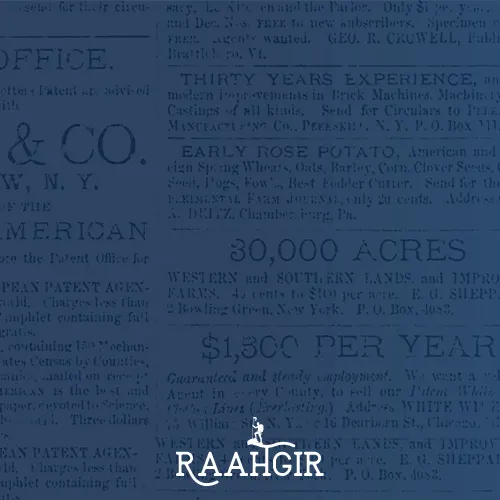
Newsletter
Sign up now!
Be the first one to know all about the Exciting Offers, Travel Updates and more.

B-42, 2nd Floor, Tower- B, The Corenthum, Block A, Sector 62, Noida, Uttar Pradesh 201301
© 2015-2025 JustWravel Pvt. Ltd.

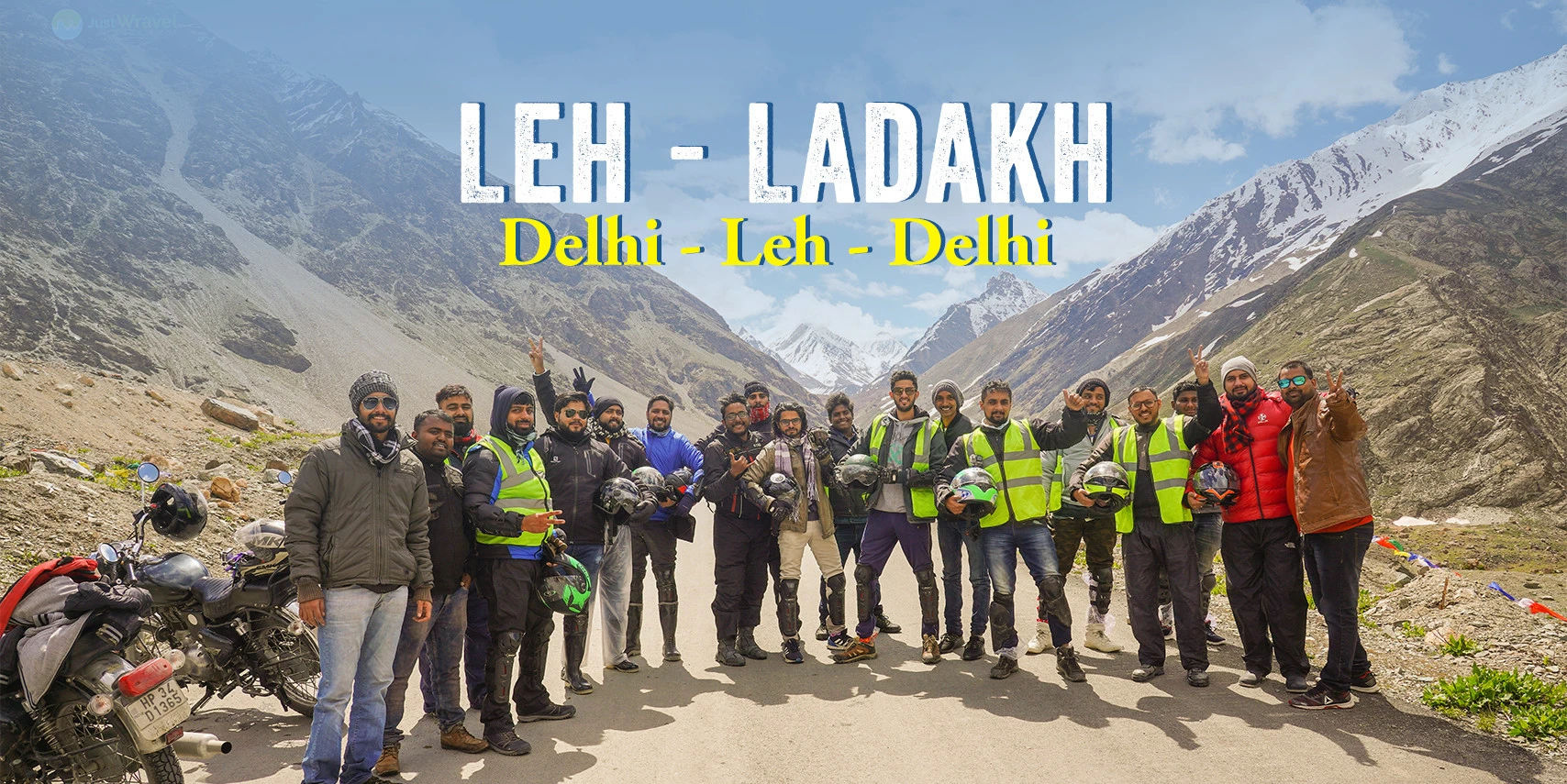


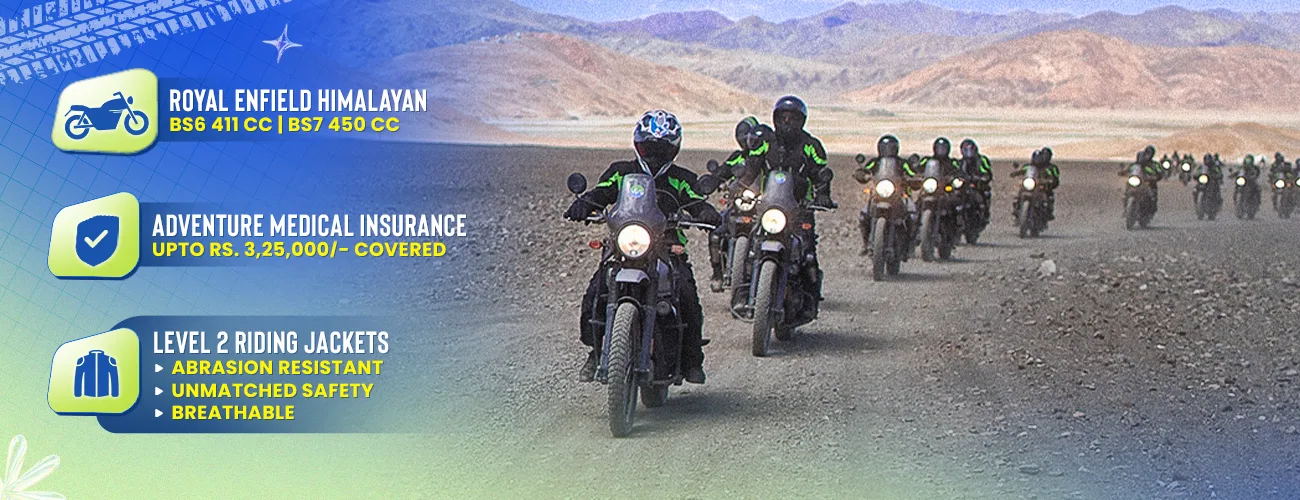
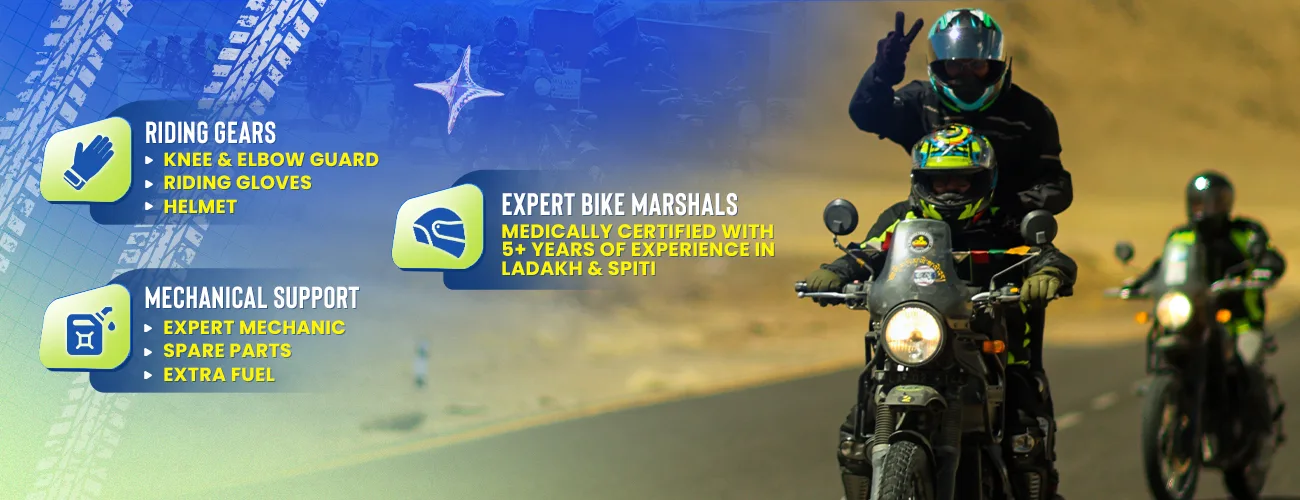
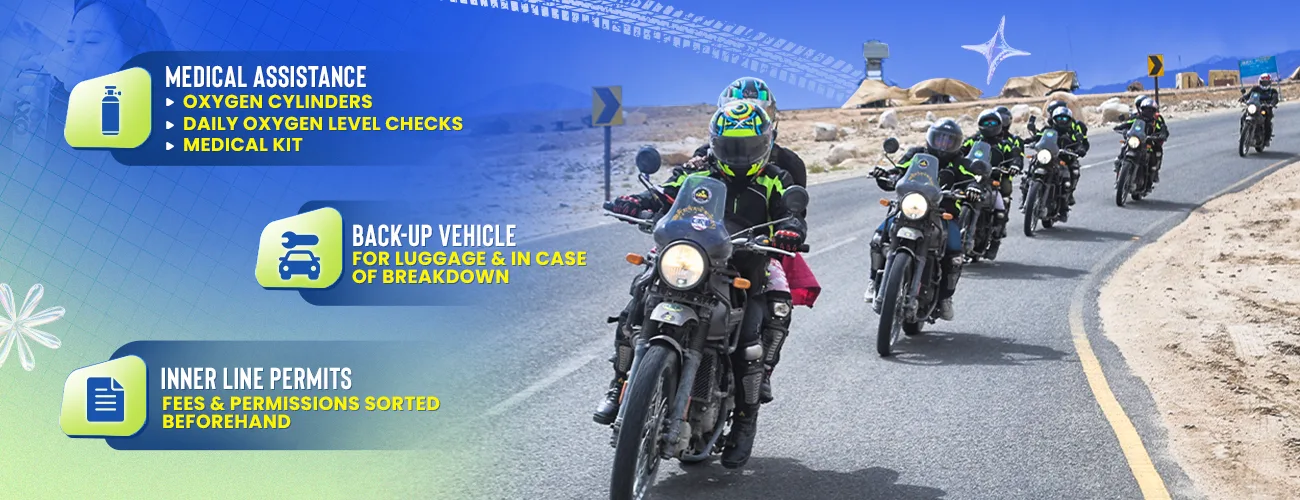




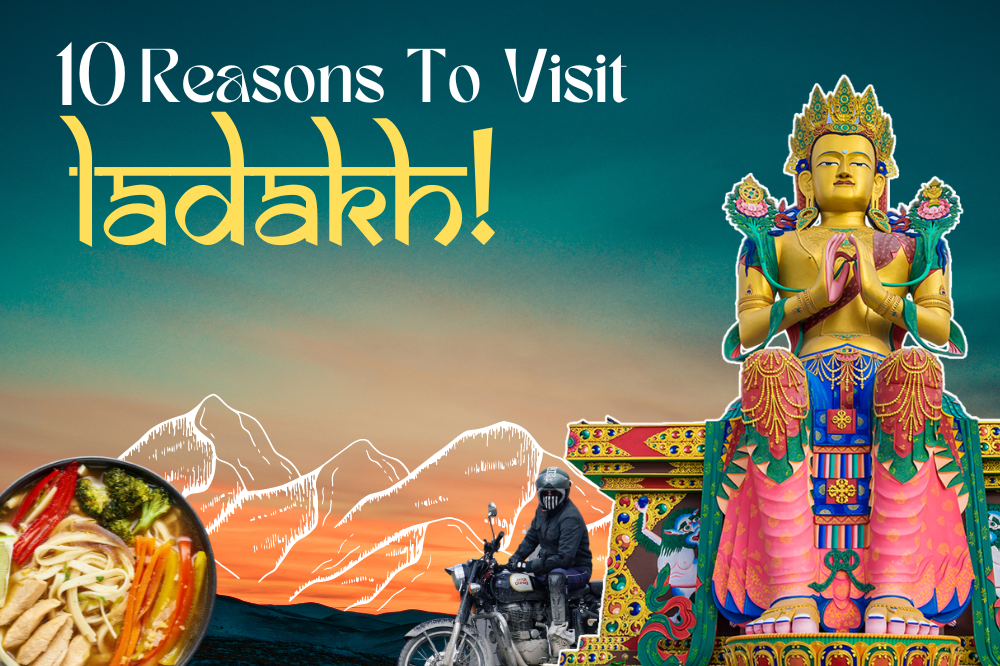
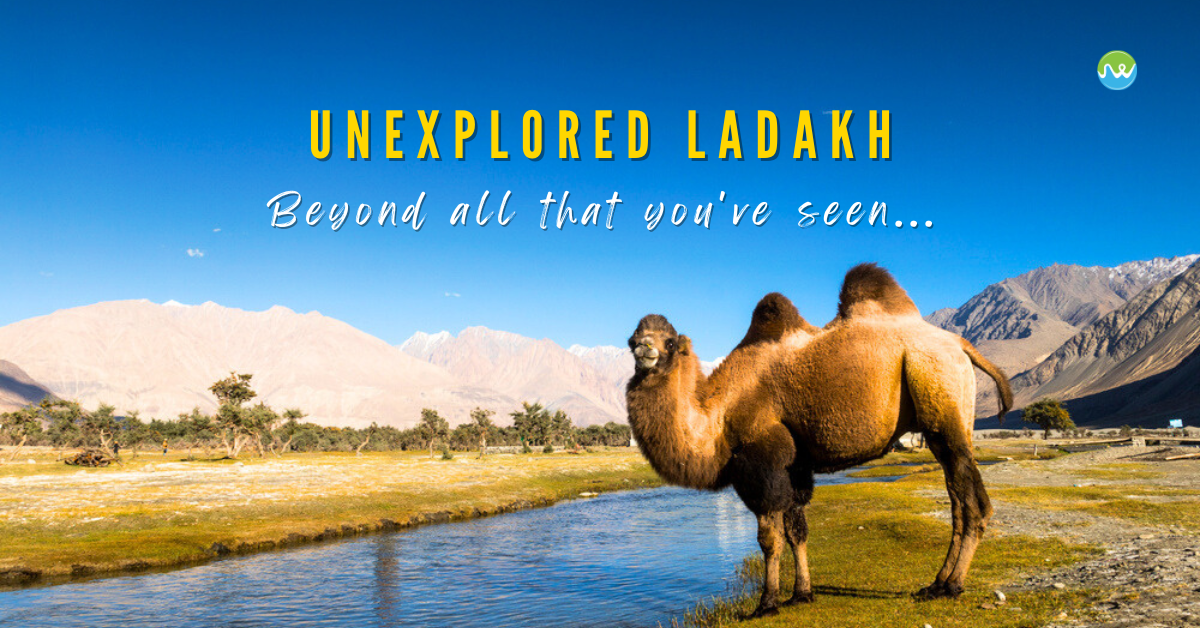

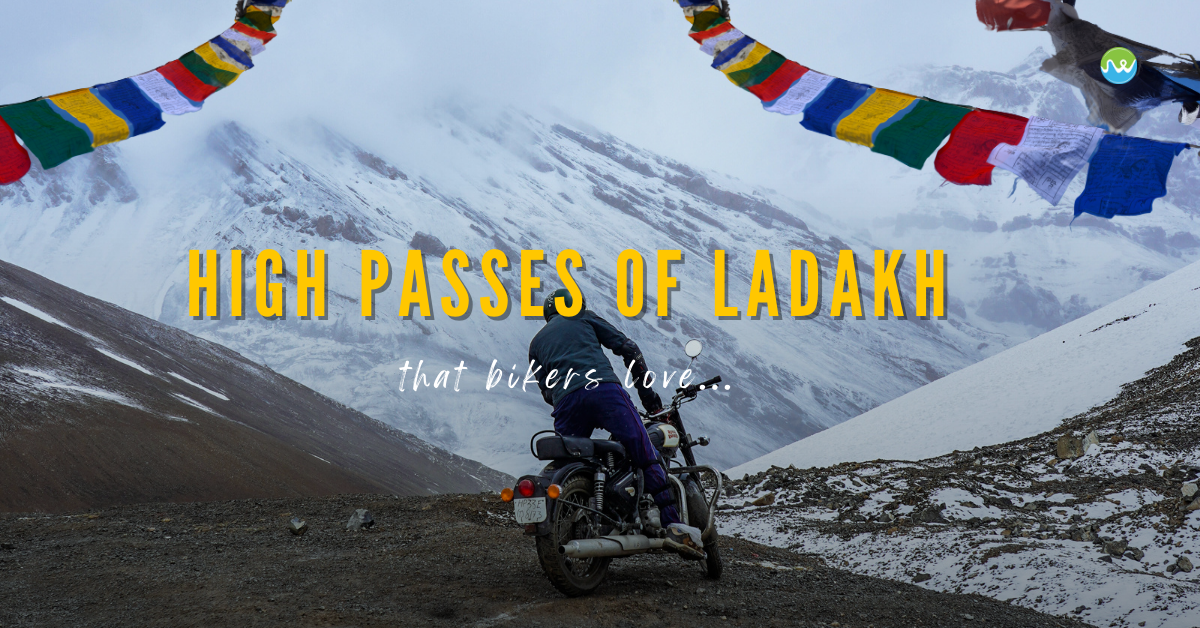
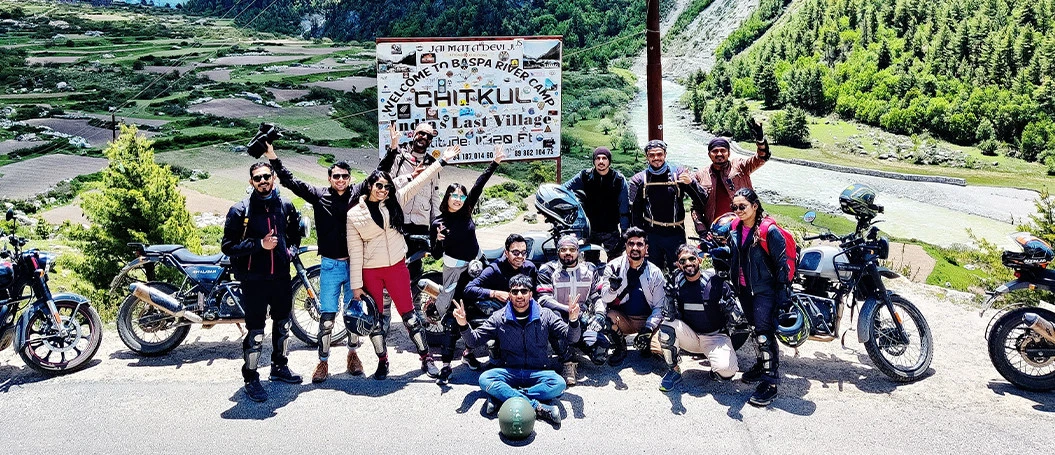
-5.jpg.webp)
